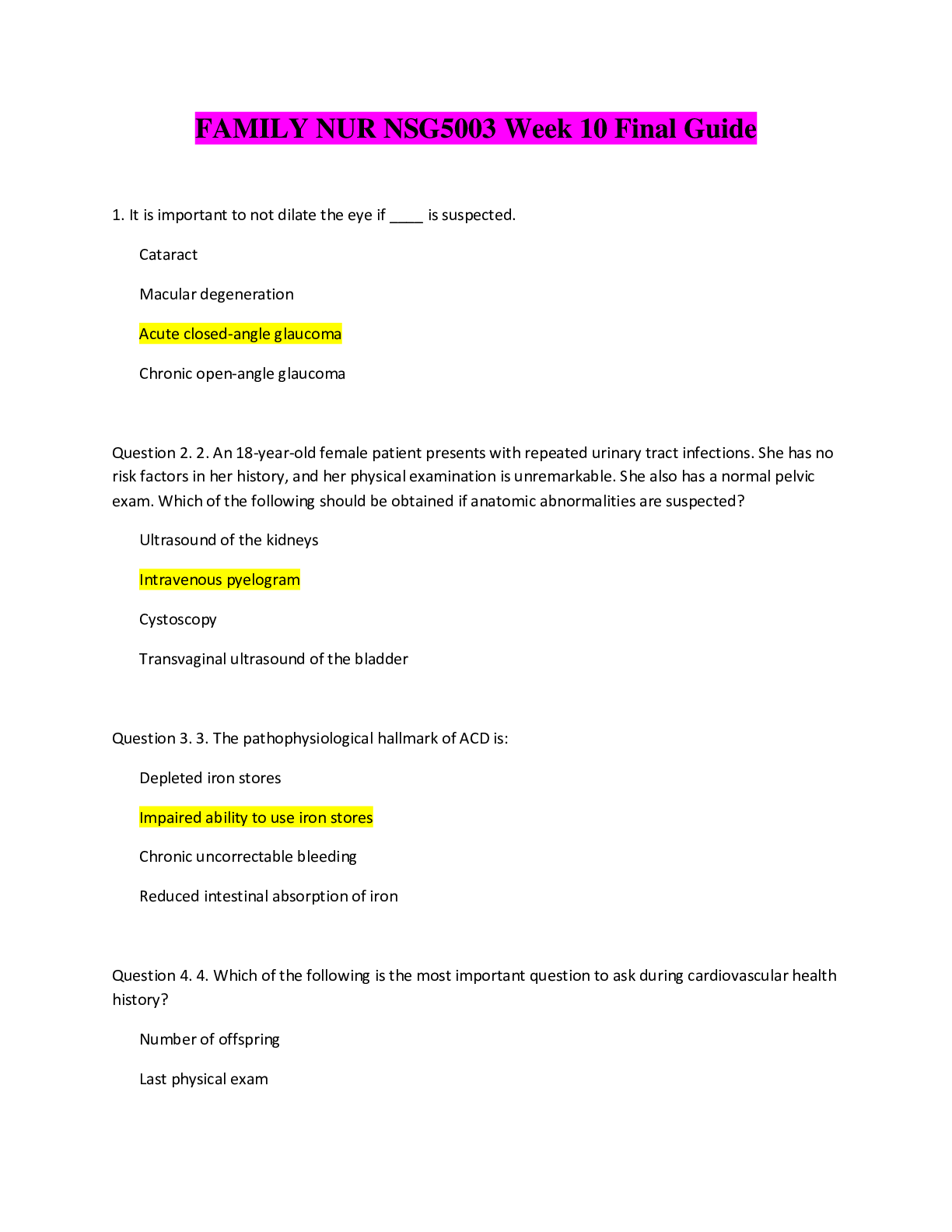*NURSING > STUDY GUIDE > NSG 5003 Week 10 Final study guide (latest) – South University (A grade) (All)
NSG 5003 Week 10 Final study guide (latest) – South University (A grade)
Document Content and Description Below
NSG 5003 Week 10 Final study guide (latest) – South University (A grade) 1. It is important to not dilate the eye if ____ is suspected. Cataract Macular degeneration Acu... te closed-angle glaucoma Chronic open-angle glaucoma Question 2. 2. An 18-year-old female patient presents with repeated urinary tract infections. She has no risk factors in her history, and her physical examination is unremarkable. She also has a normal pelvic exam. Which of the following should be obtained if anatomic abnormalities are suspected? Ultrasound of the kidneys Intravenous pyelogram Cystoscopy Transvaginal ultrasound of the bladder Question 3. 3. The pathophysiological hallmark of ACD is: Depleted iron stores Impaired ability to use iron stores Chronic uncorrectable bleeding Reduced intestinal absorption of iron Question 4. 4. Which of the following is the most important question to ask during cardiovascular health history? Number of offspring Last physical exam Sudden death of a family member Use of caffeine Question 5. 5. A 26-year-old, non-smoker, male presented to your clinic with SOB with exertion. This could be due to: Exercise-induced cough Bronchiectasis Alpha-1 deficiency Pericarditis Question 6. 6. Which of the following dermatological conditions results from reactivation of the dormant varicella virus? Tinea versicolor Seborrheic keratosis Verruca Herpes zoster Question 7. 7. Mr. Jones is a 68-year-old retired Air Force pilot that has been diagnosed with prostate cancer in the past week. He has never had a surgical procedure in his life and seeks clarification on the availability of treatments for prostate cancer. He asks the nurse practitioner to tell him the side effects of a radical prostatectomy. Which of the following is not a potential side effect of this procedure? Urinary incontinence Impotence Dribbling urine Selected low back pain Question 8. 8. Presbycusis is the hearing impairment that is associated with: Physiologic aging Ménière’s disease Cerumen impaction Herpes zoster Question 9. 9. Asymptomatic 1+ bacteriuria is found in a nursing home resident with an indwelling catheter. The nurse practitioner’s initial intervention includes: Assessing resident’s cognitive status and last change of the catheter/bag Prescribing prophylactic Bactrim 1 tablet at bedtime Ordering a urine culture and sensitivity and prescribing empiric treatment until results obtained Ordering an X-ray of the kidney, urine, and bladder Question 10. 10. A 64-year-old male presents with erythema of the sclera, tearing, and bilateral pruritus of the eyes. The symptoms occur intermittently throughout the year and he has associated clear nasal discharge. Which of the following is most likely because of the inflammation? Bacterium Allergen Virus Fungi Question 11. 11. The nurse practitioner is examining a 62-year-old female who has been complaining of lower abdominal pain. Upon auscultation, bowel sounds are high pitched and tinkling. Which of the following terms describes this finding? Succession splash Borborygmi Tenesmus Puddle sign Question 12. 12. Which ethnic group has the highest incidence of prostate cancer? Asians Hispanics African Americans American Indians Question 13. 13. A key symptom of ischemic heart disease is chest pain. However, angina equivalents may include exertional dyspnea. Angina equivalents are important because: Women with ischemic heart disease many times do not present with chest pain Some patients may have no symptoms or atypical symptoms; diagnosis may only be made at the time of an actual myocardial infarction Elderly patients have the most severe symptoms A & B only Question 14. 14. The nurse practitioner is discussing lifestyle changes with a patient diagnosed with gastroesophageal reflux. What are the nonpharmacological management interventions that should be included? Weight reduction and rest 30 minutes after each meal in the supine position Elevation of head of the bed 4-6 inches on blocks and weight reduction Encouraged to wear restrictive clothing to add support for diaphragmatic breathing Using oral mints to relieve gastric distress Question 15. 15. Which lesions are typically located along the distribution of dermatome? Scabies Herpes zoster Tinea Dyshidrosis Question 16. 16. Which of the following medications are commonly associated with the side effect of cough? Beta blocker Diuretic ACE inhibitor Calcium antagonist Question 17. 17. On DRE, you note that a 45-year-old patient has a firm, smooth, non-tender but asymmetrically shaped prostate. The patient has no symptoms and has a normal urinalysis. The patient’s PSA is within normal limits for the patient’s age. The clinician should: Refer the patient for transrectal ultrasound guided prostate biopsy Obtain an abdominal X-ray of kidneys, ureter, and bladder Recognize this as a normal finding that requires periodic follow up Obtain urine culture and sensitivity for prostatitis Question 18. 18. Your patient complains of a feeling of heaviness in the lower legs daily. You note varicosities, edema, and dusky color of both ankles and feet. Which of the following is the most likely cause for these symptoms? Femoral vein thrombosis Femoral artery thrombus Venous insufficiency Musculoskeletal injury Question 19. 19. The most common cause of eye redness is: Conjunctivitis Acute glaucoma Head trauma Corneal abrasion Question 20. 20. The aging process causes what normal physiological changes in the heart? The heart valve thickens and becomes rigid, secondary to fibrosis and sclerosis Cardiology occurs along with prolapse of the mitral valve and regurgitation Dilation of the right ventricle occurs with sclerosis of pulmonic and tricuspid valves Hypertrophy of the right ventricle Question 21. 21. Ms. Smith, 37-year-old, comes to the clinic today complaining of dull, throbbing bilateral headaches almost every evening. You suspect she is experiencing: cluster headaches migraine headaches tension headaches benign intracranial hypertension Question 22. 22. A 59-year-old patient with history of alcohol abuse comes to your office because of ‘throwing up blood”. On physical examination, you note ascites and caput medusa. A likely cause for the hematemesis is: Peptic ulcer disease Barrett’s esophagus Esophageal varices Pancreatitis Question 23. 23. Which of the following is considered a “red flag” when diagnosing a patient with pneumonia? Fever of 102 Infiltrates on chest X-ray Pleural effusion on chest X-ray Elevated white blood cell count Question 24. 24. Your patient complains of lower abdominal pain, anorexia, extreme fatigue, unintentional weight loss of 10 pounds in last 3 weeks, and you find a positive hemoccult on digital rectal examination. Laboratory tests show iron deficiency anemia. The clinician needs to consider: Diverticulitis Colon cancer Appendicitis Peptic ulcer disease Question 25. 25. You have a patient complaining of vertigo and want to know what could be the cause. Knowing there are many causes for vertigo, you question the length of time the sensation lasts. She tells you several hours to days and is accompanied by tinnitus and hearing loss. You suspect which of the following conditions? Ménière’s disease Benign paroxysmal positional vertigo Transient ischemic attack (TIA) Migraine Question 26. 26. In examining the mouth of an older adult with a history of smoking, the nurse practitioner finds a suspicious oral lesion. The patient has been referred for a biopsy to be sent for pathology. Which is the most common oral precancerous lesion? Fictional keratosis Keratoacanthoma Lichen planus Leukoplakia Question 27. 27. A cough is described as chronic if it has been present for: 2 weeks or more 8 weeks or more 3 months or more 6 months or more Question 28. 28. The first assessment to complete related to the eyes is: Eye lids Visual acuity Extraocular movements Peripheral vision Question 29. 29. The Mini-Cog is a short screening tool used to assess cognition. Which of the following statements pertaining to the test is a true statement? The patient will be asked to repeat five words immediately following the directions by the practitioner. The patient is asked to draw the hour and minute hands on a picture of an analog clock. A score of 0-2 is a positive screen for dementia. The patient is asked to recall five images from picture cards following the drawing of the clock hands. Question 30. 30. A woman with an X-linked dominant disorder will: Not be affected by the disorder herself Transmit the disorder to 50% of her offspring (male or female) Not transmit the disorder to her daughters Transmit the disorder to only her daughters Question 31. 31. Your patient has just returned from a 6-month missionary trip to Southeast Asia. He reports unremitting cough, hemoptysis, and an unintentional weight loss of 10 pounds over the last month. These symptoms should prompt the clinician to suspect: Legionnaires' disease Malaria Tuberculosis Pneumonia Question 32. 32. In assessing the eyes, which of the following is considered a “red flag” finding when associated with eye redness? History of prior red-eye episodes Grossly visible corneal defect Exophthalmos Photophobia Question 33. 33. The best evidence rating drugs to consider in a post myocardial infarction patient include: ASA, ACE/ARB, beta-blocker, aldosterone blockade ACE, ARB, Calcium channel blocker, ASA Long-acting nitrates, warfarin, ACE, and ARB ASA, clopidogrel, nitrates Question 34. 34. In examination of the nose, the clinician observes gray, pale mucous membranes with clear, serous discharge. This is most likely indicative of: Bacterial sinusitis Allergic rhinitis Drug abuse Skull fracture Question 35. 35. Which of the following findings should trigger an urgent referral to a cardiologist or neurologist? History of bright flash of light followed by significantly blurred vision History of transient and painless monocular loss of vision History of monocular severe eye pain, blurred vision, and ciliary flush All of the above Question 36. 36. Which symptom is more characteristic of Non-Cardiac chest pain? Pain often radiates to the neck, jaw, epigastrium, shoulder, or arm Pain tends to occur with movement, stretching or palpation Pain usually lasts less than 10 minutes and is relieved by nitroglycerine Pain is aggravated by exertion or stress Question 37. 37. Aortic regurgitation requires medical treatment for early signs of CHF with: Beta blockers ACE inhibitors Surgery Hospitalization Question 38. 38. What test is used to confirm the diagnosis of appendicitis? CBC Flat plate of abdomen Rectal exam CT of abdomen with attention to appendix Question 39. 39. The major impact of the physiological changes that occur with aging is: Reduced physiological reserve Reduced homeostatic mechanisms Impaired immunological response All of the above Question 40. 40. A smooth round nodule with a pearly gray border and central induration best describes which skin lesion? Seborrheic keratosis Malignant melanoma Herpes zoster Basal cell carcinoma Question 41. 41. A 20-year-old engineering student complains of episodes of abdominal discomfort, bloating, and episodes of diarrhea. The symptoms usually occur after eating, and pain is frequently relieved with bowel movement. She is on a “celiac diet” and the episodic symptoms persist. Physical examination and diagnostic tests are negative. Colonoscopy is negative for any abnormalities. This is a history and physical consistent with: Inflammatory bowel disease Irritable bowel syndrome Giardiasis Norovirus gastroenteritis Question 42. 42. Which of the following disorders can cause urinary incontinence? Cystocele Overactive bladder Uterine prolapse All of the above Question 43. 43. Which of the following drugs would be useful for the nurse practitioner to prescribe for an older adult to prevent gastric ulcers when a nonsteroidal anti-inflammatory drug is used for chronic pain management? Misoprostol (Cytotec) Cimetidine (Tagamet) Metronidazole (Flagyl) Bismuth subsalicylate (Pepto bismol) Question 44. 44. Which of the following details are NOT considered while staging asthma? Nighttime awakenings Long-acting beta agonist usage Frequency of symptoms Spirometry findings Question 45. 45. A 66-year-old patient presents to the clinic complaining of dyspnea and wheezing. The patient reports a smoking history of 2 packs of cigarettes per day since age 16. This would be recorded in the chart as: 50 x 2-pack years 100-pack years 50-year, 2-pack history 100-pack history Question 46. 46. A clinical clue for suspected renal artery stenosis would be: Decreased urine output Development of resistant hypertension in a previously well-controlled patient Retroperitoneal pain on the affected side Rising BUN level with normal creatinine level Question 47. 47. What is the most common valvular heart disease in the older adult? Aortic regurgitation Aortic stenosis Mitral regurgitation Mitral stenosis Question 48. 48. The cytochrome p system involves enzymes that are generally: Inhibited by drugs Induced by drugs Inhibited or induced by drugs Associated with decreased liver perfusion Question 49. 49. Which of the following is the most common cause of heartburn-type epigastric pain? Decreased lower esophageal sphincter tone Helicobacter pylori infection of stomach Esophageal spasm Peptic ulcer disease Question 50. 50. A nurse practitioner reports that your patient’s abdominal X-ray demonstrates multiple air-fluid levels in the bowel. This is a diagnostic finding found in: Appendicitis Cholecystitis Bowel Obstruction Diverticulitis Question 51. 51. A patient suffered a laceration of the shin three days ago, and today presents with a painful, warm, red swollen region around the area. The laceration has a purulent exudate. The clinician should recognize that the infected region is called: Contact dermatitis Folliculitis Hidradenitis suppurativa Cellulitis Question 52. 52. A 62-year-old client presents with a complaint of fever, pain, and burning on urination. Difficulty urinating with dribbling has been increasing in the past few days. He has a feeling of pressure in his groin. On examination, his prostate is tender, boggy, and warm. A stat urinalysis reveals the presence of leukocytes and bacteria. He is allergic to sulfa drugs. His weight is 70 kg and his last serum creatinine was 1.0. While awaiting the culture and sensitivity, the nurse practitioner begins empiric treatment with which of the following? Trimethoprim/sulfamethoxazole DS bid x 2 weeks Ampicillin 250 mg PO Q day for 10 days Nitrofurantoin 100 mg Q 12 hours for 7 days Ciprofloxacin 500 mg Q 12 hours for 14 days Question 53. 53. In teaching an older adult female client with end-stage renal disease her medication regimen, the nurse practitioner must include which of the following pieces of information in the treatment plan? Report any changes in the color of her stool Take iron supplement and elemental calcium with each meal Take iron supplement before meals and the calcium after meals Take calcium with a high phosphorus meal Question 54. 54. A 46-year-old female complains of fatigue, general malaise, and pain and swelling in her hands that has gradually worsened over the last few weeks. She reports that pain, stiffness, and swelling of her hands are most severe in the morning. On physical examination, you note swelling of the metacarpophalangeal joints bilaterally. These are common signs of: Osteoarthritis Rheumatoid arthritis Scleroderma Sarcoidosis Question 55. 55. Whenever a patient presents with acute non-traumatic shoulder pain, the clinician should make sure to exclude a: Cardiac origin of symptoms Gastrointestinal condition Cervical spine disorder All of the above Question 56. 56. A female patient presents to the clinic with complaints of a severe, throbbing, unilateral headache. She complains of seeing flashes of light prior to the headache. She complains of sound and light sensitivity as well as nausea. The clinician should recognize these as symptoms of: Epilepsy with aura Cluster headache Migraine headache Normal pressure hydrocephalus Question 57. 57. The main focus of treatment of patients with ACD is: Replenishing iron stores Providing for adequate nutrition high in iron Management of the underlying disorder Administration of monthly vitamin B12 injections Question 58. 58. The most common neurological cause of seizures in an older adult is: Alzheimer’s disease Multiple sclerosis Stroke Peripheral neuropathy Question 59. 59. Your 63-year-old Caucasian woman with polymyalgia rheumatica (PMR) will begin treatment with corticosteroids until the condition has resolved. You look over her records and it has been 2 years since her last physical examination and any laboratory or diagnostic tests as she relocated and had not yet identified a health-care provider. In prioritizing your management plan, your first orders should include: Recommending she increase her dietary intake of Calcium and Vitamin D Ordering once a year bisphosphonate and a proton pump inhibitor Participate in a fall prevention program Dual-energy X-ray (DEXA) scan and updating immunizations Question 60. 60. Your patient is a 78-year-old female with a smoking history of 120-pack years. She complains of hoarseness that has developed over the last few months. It is important to exclude the possibility of: Thrush Laryngeal cancer Carotidynia Thyroiditis Question 61. 61. A 43-year-old female was in a bicycling accident and complains of severe pain of the right foot. The patient limps into the emergency room. On physical examination, there is no point tenderness over the medial or lateral ankle malleolus. There is no foot tenderness except at the base of the fifth metatarsal bone. According to the Ottawa foot rules, should an X-ray of the feet be ordered? Yes, there is tenderness over the fifth metatarsal No, there is not tenderness over the navicular bone Yes, the patient cannot bear weight on the foot A and C Question 62. 62. When assessing a patient who complains of a tremor, the nurse practitioner must differentiate essential tremor from the tremor of Parkinson’s disease. Which of the following findings are consistent with essential tremor? The handwriting is not affected by the tremor The tremor occurs with purposeful movements The tremor occurs at rest The tremor gets worse with alcohol ingestion Question 63. 63. Folliculitis is most commonly due to: Contact dermatitis Varicella zoster Dermatophytes Staphylococcal infection Question 64. 64. What kind of lesions are caused by the herpes simplex virus? Scales Vesicles Plaques Urticaria Question 65. 65. A 65-year-old male complains of a headache that feels “like a knife is cutting into his head.” He also reports feeling right-sided scalp and facial pain and “seeing double” at times. He has a history of hypertension and hyperlipidemia. His medications include beta blocker, statin drug, and an ACE inhibitor. On physical examination, you note palpable tenderness over the right side of the forehead. There are no neurological deficits. Vision is 20/20 with lenses. No weakness of extremities. CN II to XII are intact. The history corresponds to which of the following disorders? Drug toxicity Giant cell arteritis Cluster headache Migraine headache Question 66. 66. Which of the following conditions is the most common cause of nausea, vomiting, and diarrhea? Viral gastroenteritis Staphylococcal food poisoning Acute hepatitis A E coli gastroenteritis Question 67. 67. The nurse practitioner orders bilateral wrist X-rays on a 69-year-old gentleman complaining of pain in both wrists for the past 6 weeks not related to any known trauma. The nurse practitioner suspects elderly onset rheumatoid arthritis. The initial radiographic finding in a patient with elderly onset rheumatoid arthritis would be: Symmetric joint space narrowing Soft tissue swelling Subluxations of the joints Joint erosions Question 68. 68. A common auscultatory finding in advanced CHF is: Systolic ejection murmur S3 gallop rhythm Friction rub Bradycardia Question 69. 69. The three cardinal features of Parkinson’s disease are: Essential tremor, postural rigidity, and infarcts of the basal ganglion Bradykinesia, rigidity, and tremor Shuffling gait, constipation, positional freezing. Dementia, incontinence, and infarcts of the basal ganglion Question 70. 70. In AR disorders, carriers have: Two mutated genes; one from each parent that cause disease A mutation on a sex chromosome that causes a disease A single gene mutation that causes the disease One copy of a gene mutation but not the disease Question 71. 71. A 75-year-old patient complains of pain and paresthesias in the right foot that worsens with exercise and is relieved by rest. On physical examination you note pallor of the right foot, capillary refill of 4 seconds in the right foot, +1 dorsalis pedis pulse in the right foot, and +2 pulse in left foot. Which of the following is a likely cause of the signs and symptoms? Arterial insufficiency Femoral vein thrombus Venous insufficiency Peripheral neuropathy Question 72. 72. Which of the following statements is true concerning anti-arrhythmic drugs? Amiodarone is the only one not associated with increased mortality and it has a very favorable side effect profile. Both long-acting and short-acting calcium channel blockers are associated with an increased risk of cardiovascular morbidity and mortality. Most anti-arrhythmics have a low toxic/therapeutic ratio and some are exceedingly toxic. Anti-arrhythmic therapy should be initiated in the hospital for all patients. Question 73. 73. A 23-year-old patient who has had bronchiectasis since childhood is likely to have which of the following: Barrel-shaped chest Clubbing Pectus excavatum Prolonged capillary refill Question 74. 74. Which of the following is a common trigger of migraine headache? Missed meals Menses Alcohol All of the above Question 75. 75. A 55-year-old patient complains of lower back pain due to heavy lifting at work yesterday. He reports weakness of the left leg and paresthesias in the left foot. On physical examination, the patient has diminished ability to dorsiflex the left ankle. Which of the following symptoms should prompt the clinician to make immediate referral to a neurosurgeon? Straight leg raising sign Lumbar herniated disc on X-ray Loss of left sided patellar reflex Urinary incontinence Question 76. 76. The appearance of a 2-10 cm. herald patch with subsequent development of parallel oval lesions on the trunk in a christmas tree distribution involving the upper arms and upper legs are common in: Pityriasis Rosea Shingles Psoriasis Lymes Disease Question 77. 77. When interpreting laboratory data, you would expect to see the following in a patient with Anemia of Chronic Disease (ACD): Hemoglobin <12 g/dl, MCV decreased, MCH decreased Hemoglobin >12 g/dl, MCV increased, MCH increased Hemoglobin <12 g/dl, MCV normal, MCH normal Hemoglobin >12 g/dl, MCV decreased, MCH increased Question 78. 78. In differentiating a gastric ulcer from a duodenal ulcer, you know that each type of ulcer can present with distinct signs and symptoms. Which of the following pieces of information from the patient’s history is the least useful for you to determine that the patient has a duodenal ulcer? Pain occurs on an empty stomach Diffuse epigastric pain Rarely associated with non-steroidal use Occurs in patients under 40 years of age Question 79. 79. A 43-year-old male patient complains of right-sided abdominal and pain in the back in the right costovertebral angle region, fever, chills, dysuria, and nausea. On physical examination, there is 102 degree fever, tachycardia, and right costovertebral angle tenderness to percussion. The most likely condition is: Lower urinary tract infection Nephrolithiasis Hydronephrosis Pyelonephritis Question 80. 80. A careful history of a female client with a chief complaint of intermittent diarrhea reveals that she also experiences bouts of constipation. She has no known allergies and experienced no unintentional weight loss. What is the most likely condition? Inflammatory bowel disease Irritable bowel syndrome Giardiasis Lactose intolerance Question 81. 81. A 33-year-old female reports general malaise, fatigue, stiffness, and pain in multiple joints of the body. There is no history of systemic disease and no history of trauma. On physical examination, the patient has no swelling or decreased range of motion in any of the joints. She indicates specific points on the neck and shoulders that are particularly affected. She complains of tenderness upon palpation of the neck, both shoulders, hips, and medial regions of the knees. The clinician should include the following disorder in the list of potential diagnoses: Osteoarthritis Rheumatoid arthritis Fibromyalgia Polymyalgia rheumatica Question 82. 82. A 60-year-old female patient complains of pain in both hands that is worse in the morning. On physical examination, the thumb metacarpophalangeal joint is swollen on both hands. There is swelling of the proximal and distal interphalangeal joints bilaterally. These are typical signs of: Osteoarthritis Rheumatoid arthritis Normal aging Gouty arthritis Question 83. 83. A 68-year-old male reports painless rectal bleeding occasionally noted with thin pencil-like stools, but no pain with defection. He has a history of colon polyp removal 10 years ago but was lost to follow-up. The nurse practitioner’s appropriate intervention is: Digital rectal exam and send home with 3 hemoccult to return Immediate referral to gastroenterologist and colonoscopy Order a screening sigmoidoscopy Order a colonoscopy and barium enema and refer based on results Question 84. 84. During physical examination of a patient, you note resonance on percussion in the upper lung fields. This is consistent with: COPD Pneumothorax A normal finding Pleural effusion Question 85. 85. Your 70-year-old patient has gastroesophageal reflux disease (GERD). After a trial of lifestyle modifications and antacids, the patient continues to have occasional mild heartburn after occasional meals and at night. The most appropriate next action is: Prokinetic agents H2 antagonists Proton pump inhibitors Sucralfate Question 86. 86. In order to provide a comprehensive genetic history of a patient, the NP should: Ask patients to complete a family history worksheet Seek out pathology reports related to the patient’s disorder Interview family members regarding genetic disorders All of the above Question 87. 87. An 86-year-old patient who wears a hearing aid complains of poor hearing in the affected ear. In addition to possible hearing aid malfunction, this condition is often due to: Acoustic neuroma Cerumen impaction Otitis media Ménière’s disease Question 88. 88. A 62-year-old woman presents with a recurrent urinary tract infection. She now has a fever of 104°F and severe costovertebral tenderness with pyuria. What is the appropriate diagnosis and intervention for this patient? Septic arthritis and oral prednisolone is indicated Pyelonephritis and hospitalization is required Recurrent cystitis and 10 days of antibiotics are needed Pelvic inflammatory disease and 7 days of antibiotics are indicated Question 89. 89. When counseling clients regarding the use of antidiarrheal drugs such as Imodium anti-diarrheal and Kaopectate, the nurse practitioner advises patients to: Use all the medication Do not use for possible infectious diarrhea Use should exceed one week for effectiveness These drugs provide exactly the same pharmaceutical effects Question 90. 90. What is the most common cause of hip pain in older adults? Osteoporosis Osteoarthritis Trauma due to fall Trochanteric bursitis Question 91. 91. A 65-year-old woman is accompanied by her daughter for a physical examination. She has mild heart failure and takes digitalis and an ACE inhibitor. As you examine the patient, you note flat affect, hand tremor, and slowed movements. The tremor is worsened at rest. There are no neurologic deficits. Hand grip, sensation of face and extremities, and lower extremity muscle strength are within normal limits and bilaterally equal. DTRs are equal bilaterally. CN II to XII are intact. The mental status exam is normal. These are key signs of: Chiari malformation Normal pressure hydrocephalus Parkinson’s disease Drug toxicity Question 92. 92. An older patient reports burning pain after ingestion of many foods and large meals. What assessment would assist the nurse practitioner in making a diagnosis of GERD? Identification of a fluid wave Positive Murphy’s sign Palpable spleen Midepigastric pain that is not reproducible with palpation Question 93. 93. An 82-year-old female presents to the emergency department with epigastric pain and weakness. She admits to having dark, tarry stools for the last few days. She reports a long history of pain due to osteoarthritis. She self-medicates daily with ibuprofen, naprosyn, and aspirin for joint pain. On physical examination, she has orthostatic hypotension and pallor. Fecal occult blood test is positive. A likely etiology of the patient’s problem is: Mallory-Weiss tear Esophageal varices Gastric ulcer Colon cancer Question 94. 94. Your 2-year-old patient shows facial features, such as epicanthal folds, up-slanted palpebral fissures, single transverse palmar crease, and a low nasal bridge. These are referred to as: Variable expressivity related to inherited disease Dysmorphic features related to genetic disease De novo mutations of genetic disease Different penetrant signs of genetic disease Question 95. 95. The first step in the genomic assessment of a patient is obtaining information regarding: Family history Environmental exposures Lifestyle and behaviors Current medications Question 96. 96. Your patient is a 43-year-old female golfer who complains of arm pain. On physical examination, there is point tenderness on the elbow and pain when the patient is asked to flex the wrist against the clinician’s resistance. These are typical signs of: Carpal tunnel syndrome Osteoarthritis of the wrist Epicondylitis Cervical osteoarthritis Question 97. 97. Upon assessment of respiratory excursion, the clinician notes asymmetric expansion of the chest. One side expands greater than the other. This could be due to: Pneumothorax Pleural effusion Pneumonia Pulmonary embolism Question 98. 98. Which of the following symptoms is common with acute otitis media? Bulging tympanic membrane Bright light reflex of tympanic membrane Increased tympanic membrane mobility All of the above Question 99. 99. A 75-year-old patient with community-acquired pneumonia presents with temperature of 102.1, chills, productive cough, BP 90/5062, WBC 12,000, and blood urea nitrogen (BUN) 20 mg/dl. He has a history of mild dementia and his mental status is unchanged from his last visit. These findings indicate that the patient: Can be treated as an outpatient Requires hospitalization for treatment Requires a high dose of parenteral antibiotic Can be treated with oral antibiotics Question 100. 100. A 34-year-old female presents with fever, general malaise, fatigue, arthralgias and rash for the last 2 weeks. On physical examination, you note facial erythema across the nose and cheeks. Serum diagnostic tests reveal positive antinuclear antibodies, anti-DNA antibodies, elevated C-reactive protein and erythrocyte sedimentation rate. The clinician should include the following disorder in the list of potential problems: Fibromyalgia Sarcoidosis Systemic lupus erythematosus Rheumatoid arthritis Question 101. 101. A pneumatic otoscopic examination is used to assess: Inner ear conditions Otitis externa Cerumen impaction Tympanic membrane mobility Question 102. 102. An elderly patient has had a CVA in the anterior cerebral circulatory system (frontal lobe). What symptoms are most likely expressed? Neglect of body and difficulty organizing space Wernicke’s aphasia (difficulty understanding speech) Disorders of behavior and cognition Bilateral motor and sensory problem Question 103. 103. Asymmetrical bi-color lesion with irregular border measuring 8 mm is found on the right lower arm of an adult patient. This assessment finding is consistent with: Melanoma Basal cell carcinoma Leukoplakia Senile lentigines Question 104. 104. Iron Deficiency Anemia (IDA) is classified as a microcytic, hypochromic anemia. This classification refers to which of the following laboratory data? Hemoglobin and Hematocrit Mean Corpuscular Volume (MCV) and Mean Corpuscular Hemoglobin (MCH) Serum ferritin and Serum iron Total iron binding capacity and transferrin saturation Question 105. 105. On a physical examination for employment, a 45-year-old male shows no significant findings and takes no medications. Past medical history and surgery are unremarkable. On urinalysis, hematuria is present. The urinalysis is repeated on another day and still reveals microscopic hematuria. It is important to recognize that painless hematuria can be diagnostic of: Urinary tract infection Bladder cancer Nephrolithiasis Pyelonephritis Question 106. 106. A 17-year-old male complains of severe right knee pain. He was playing football when he heard a “pop” at the moment of being tackled and his knee “gave away” from under him. On physical examination, there is right knee swelling and decreased range of motion. There is a positive anterior drawer sign. These findings indicate: Knee ligament injury Osgood-Schlatter disease Prepatellar bursitis Chondromalacia patella Question 107. 107. In addition to the complete blood count (CBC) with differential, which of the following laboratory tests is considered to be most useful in diagnosing ACD and IDA? Serum iron Total iron binding capacity Transferrin saturation Serum ferritin Question 108. 108. Dan G., a 65-year-old man, presents to your primary care office for the evaluation of chest pain and left-sided shoulder pain. Pain begins after strenuous activity, including walking. Pain is characterized as dull, aching; 8/10 during activity, otherwise 0/10. Began a few months ago, intermittent, aggravated by exercise, and relieved by rest. Has occasional nausea. Pain is retrosternal, radiating to left shoulder, definitely affects quality of life by limiting activity. Pain is worse today; did not go away after he stopped walking. BP 120/80. Pulse 72 and regular. Normal heart sounds, S1 and S2, no murmurs. Which of the following differential diagnoses would be most likely? Musculoskeletal chest wall syndrome with radiation Esophageal motor disorder with radiation Acute cholecystitis with cholelithiasis Coronary artery disease with angina pectoris Question 109. 109. A middle-aged patient has been diagnosed with Parkinson’s disease. What influences the nurse practitioner’s decision to begin pharmacological treatment for this patient? Intentional tremors Gait instability requiring use of a cane Symptoms interfering with functional ability Medications initiated at first sign of unilateral involvement Question 110. 110. Essential parts of a health history include all of the following except: Chief complaint History of the present illness Current vital signs All of the above are essential history components Question 111. 111. When palpating the posterior chest, the clinician notes increased tactile fremitus over the left lower lobe. This can be indicative of pneumonia. Areas of increased fremitus should raise the suspicion of conditions resulting in increased solidity or consolidation in the underlying lung tissue, such as in pneumonia, tumor, or pulmonary fibrosis. In the instance of an extensive bronchial obstruction: No palpable vibration is felt Decreased fremitus is felt Increased fremitus is felt Vibration is referred to the non-obstructed lobe Question 112. 112. Which of the following would be considered a “red flag” that requires more investigation in a patient assessment? Colon cancer in family member at age 70 Breast cancer in family member at age 75 Myocardial infarction in family member at age 35 All of the above Question 113. 113. Your 66-year-old male patient has recently started treatment for metabolic syndrome and is currently taking the following medications: an ACE inhibitor and beta blocker for treatment of hypertension. He is also taking a statin medication, simvastatin for hyperlipidemia, and a biguanide, metformin, for type 2 diabetes. The patient complains of myalgias of the legs bilaterally and blood work shows elevated serum creatine kinase. Which of the medications can cause such a side effect? Beta blocker ACE inhibitor Statin medication Metformin Question 114. 114. Symptoms in the initial human immunodeficiency virus (HIV) infection include all of the following except: Sore throat Fever Weight loss Headache Question 115. 115. The most appropriate first-line treatment for an acute gout flare is (assuming no kidney disease or elevated bleeding risk): Indomethacin 50 mg thrice daily for 2 days; then 25 mg thrice daily for 3 days Doxycycline 100 mg twice daily for 5 days Prednisolone 35 mg four times a day for 5 days Ice therapy Question 116. 116. According to the Genetic Information Nondiscrimination Act (GINA): Nurse Practitioners (NPs) should keep all genetic information of patients confidential NPs must obtain informed consent prior to genetic testing of all patients Employers cannot inquire about an employee’s genetic information All of the above Question 117. 117. A 55-year-old post-menopausal woman with a history of hypertension complains of jaw pain on heavy exertion. There were no complaints of chest pain. Her ECG indicates normal sinus rhythm without ST segment abnormalities. Your plan may include: Echocardiogram Exercise stress test Cardiac catheterization Myocardial perfusion imaging Question 118. 118. A 27-year-old male comes in to the clinic for symptoms of dysuria, urinary frequency, as well as urgency and perineal pain. Transrectal palpation of the prostate reveals a very tender, boggy, swollen prostate. The clinician should recognize these as signs of: Prostatitis Prostate cancer Urethritis Benign prostatic hyperplasia Question 119. 119. Patient presents with complaint of a “swollen node” under his arm. The area is tender and the node has progressed in size over the past few days. Which of the following should be included in your differential diagnosis? Hidradenitis suppurativa Epidermoid cyst Furuncle Both A and C Question 120. 120. The most common complication of an untreated urinary obstruction due to a ureteral calculus is: Ureteral rupture Hydronephrosis Kidney mass Renal artery stenosis Question 121. 121. A woman complains of malaise and arthralgias. You note a butterfly-shaped, macular, erythematous rash across her cheeks and nose. These conditions are common in: Psoriasis Lichen planus Systemic lupus erythematosus Erythema nodosum Question 122. 122. Your patient has been treated for glaucoma for 5 years. Which of the following will provide indication of the level of progression during the funduscopic examination for this patient? Checking the macula Estimating cup-to-disk ratio Verifying a red reflex Extraocular movements Question 123. 123. Age-related changes in the bladder, urethra, and ureters include all of the following in older women except: Increased estrogen production’s influence on the bladder and ureter Decline in bladder outlet function Decline in ureteral resistance pressure Laxity of the pelvic muscle Question 124. 124. A 33-year-old female patient visits the clinic multiple times over the last year complaining of dysuria, frequency, urgency, suprapubic pain, and dyspareunia. Her physical examination, including a pelvic exam, is normal. Urinalysis and urine culture is repeatedly negative. Her intravenous pyelogram is also normal. The clinician should recognize that this presentation is consistent with symptoms of: Interstitial cystitis Polycystic kidneys Upper urinary tract infection Asymptomatic bacteriuria Question 125. 125. An older adult male presents with pain in his right chest wall for the past 48 hours. Upon examination, the nurse practitioner notices a vesicular eruption along the dermatome and identifies this as herpes zoster. The NP informs the gentleman that: All symptoms should disappear within three days Oral medications can dramatically reduce the duration and intensity of his symptoms He has chickenpox and can be contagious to his grandchildren He has a sexually transmitted disease Question 126. 126. Functional abilities are best assessed by: Self-report of function Observed assessment of function A comprehensive head-to-toe examination Family report of function Question 127. 127. Which of the following clinical reasoning tools is defined as evidence-based resource based on mathematical modeling to express the likelihood of a condition in select situations, settings, and/or patients? Clinical practice guideline Clinical decision rule Clinical algorithm Clinical recommendation Question 128. 128. Jenny is a 24 year old graduate student that presents to the clinic today with complaints of fever, midsternal chest pain and generalized fatigue for the past two days. She denies any cough or sputum production. She states that when she takes Ibuprofen and rest that the chest pain does seem to ease off. Upon examination the patient presents looking very ill. She is leaning forward and states that this is the most comfortable position for her. Temp is 102. BP= 100/70. Heart rate is 120/min and regular. Upon auscultation a friction rub is audible. Her lung sounds are clear. With these presenting symptoms your initial diagnosis would be: Mitral Valve Prolapse Referred Pain from Cholecystitis Pericarditis Pulmonary Embolus Question 129. 129. A 72-year-old female patient has been diagnosed with gout. She also has a long history of chronic congestive heart failure. The most likely contributing factor to the development of gout in this older female is: Lead intoxication Illegal whiskey Binge-eating Thiazide diuretics Question 130. 130. Cellulitis is a deep skin infection involving the dermis and subcutaneous tissues. The nurse practitioner suspects cellulitis in a 70-year-old Asian diabetic male presenting with reddened edematous skin around his nares. Which statement below will the nurse practitioner use in her decision-making process for the differential diagnosis pertaining to reddened edematous skin? Cellulitis is two times more common in women Facial cellulitis is more common in people >55 There is low incidence of cellulitis in patients with diabetes Cellulitis is only a disease of the lower extremities of patients with known arterial insufficiency Question 131. 131. A 22-year-old female comes to your office with complaints of right lower quadrant abdominal pain, which has been worsening over the last 24 hours. On examination of the abdomen, there is a palpable mass and rebound tenderness over the right lower quadrant. The clinician should recognize the importance of: Digital rectal examination Endoscopy Pelvic examination Urinalysis Question 132. 132. A 72-year-old woman and her husband are on a cross-country driving vacation. After a long day of driving, they stop for dinner. Midway through the meal, the woman becomes very short of breath, with chest pain and a feeling of panic. Which of the following problems is most likely? Pulmonary edema Heart failure Pulmonary embolism Pneumonia Question 133. 133. Susan P., a 60-year-old woman with a 30 pack year history, presents to your primary care practice for evaluation of a persistent, daily cough with increased sputum production, worse in the morning, occurring over the past three months. She tells you, “I have the same thing, year after year.” Which of the following choices would you consider strongly in your critical thinking process? Seasonal allergies Acute bronchitis Bronchial asthma Chronic bronchitis Question 134. 134. Your 77-year-old patient complains of frequent urination, hesitation in getting the stream started, and nocturnal frequency of urination that is bothersome. On DRE, there is an enlarged, firm, non-tender, smooth prostate. The clinician should recognize these as symptoms of: Urethritis Benign prostatic hyperplasia Prostatitis Prostate cancer Question 135. 135. During auscultation of the chest, your exam reveals a loud grating sound at the lower anterolateral lung fields, at full inspiration and early expiration. This finding is consistent with: Pneumonia Pleuritis Pneumothorax A and B Question 136. 136. A 20-year-old male construction worker is experiencing new onset of knee pain. He complains of right knee pain when kneeling, squatting, or walking up and down stairs. On physical examination, there is swelling and crepitus of the right knee and obvious pain with resisted range of motion of the knee. He is unable to squat due to pain. Which of the following disorders should be considered in the differential diagnosis? Joint infection Chondromalacia patella Prepatellar bursitis All of the above Question 137. 137. Your 35-year-old female patient complains of feeling palpitations on occasion. The clinician should recognize that palpitations are often a sign of: Anemia Anxiety Hyperthyroidism All of the above Question 138. 138. In a patient presenting with suspected recurrence of diverticulitis, abdominal pain usually presents where in the abdomen? Left upper quadrant Right upper quadrant Left lower quadrant Right lower quadrant Question 139. 139. Which of the following is not a contributing factor to the development of esophagitis in older adults? Increased gastric emptying time Regular ingestion of NSAIDs Decreased salivation Fungal infections such as Candida Question 140. 140. A 79-year-old man is being evaluated for frequent urinary dribbling without burning. Physical examination reveals a smooth but slightly enlarged prostate gland. His PSA level is 3.3 ng/ml. The patient undergoes formal urodynamic studies, and findings are as follows: a decreased bladder capacity of 370 ml; a few involuntary detrusor contractions at a low bladder volume of 246 mL; an increased postvoid residual urine volume of 225 ml; and a slightly decreased urinary flow rate. Which of the following is not consistent with a normal age-associated change? PSA level of 3.3 ng/ml Decreased bladder capacity Involuntary detrusor contradictions Increased postvoid residual urine volume Question 141. 141. A patient complains of fever, fatigue, and pharyngitis. On physical examination there is pronounced cervical lymphadenopathy. Which of the following diagnostic tests should be considered? Mono spot Strep test Throat culture All of the above Question 142. 142. Which of the following findings would indicate a need for another endoscopy in clients with peptic ulcer disease? Cases of dyspepsia with constipation Symptoms persisting after six to eight weeks of therapy All clients with dyspepsia who smoke and drink alcohol When a therapeutic response to empiric treatment is obtained Question 143. 143. Which of the following descriptions accurately documents cellulitis? Cool, erythematous, shiny hairless extremity with decreased pulse Scattered, erythematous ring-like lesions with clear centers Clearly demarcated, raised erythematous area of face Diffusely inflamed skin that is warm and tender to palpation Question 144. 144. Men have faster and more efficient biotransformation of drugs and this is thought to be due to: Less obesity rates than women Prostate enlargement Testosterone Less estrogen than women Question 145. 145. Rheumatic heart disease is a complication that can arise from which type of infection? Epstein-Barr virus Diphtheria Group A beta hemolytic streptococcus Streptococcus pneumoniae Question 146. 146. An older adult client with a history of a seizure disorder comes into the clinic for a routine check-up. Although seizure free, the client continues on long-term phenytoin treatment. The nurse practitioner would assess for which of the following long-term effects? Lid lag and nystagmus Gingival hyperplasia and nystagmus Nystagmus and microcytic anemia Gingival hyperplasia and iron deficiency anemia Question 147. 147. A 24-year-old patient presents to the emergency department after sustaining multiple traumatic injuries after a motorcycle accident. Upon examination, you note tachypnea, use of intercostal muscles to breathe, asymmetric chest expansion, and no breath sounds over the left lower lobe. It is most important to suspect: Pulmonary embolism Pleural effusion Pneumothorax Fracture of ribs Question 148. 148. Patients that have atopic disorders are mediated by the production of Immunoglobulin E (IgE) will have histamine stimulated as an immediate phase response. This release of histamine results in which of the following? Sinus pain, increased vascular permeability, and bronchodilation Bronchospasm, vascular permeability, and vasodilatation Contraction of smooth muscle, decreased vascular permeability, and vasoconstriction Vasodilatation, bronchodilation, and increased vascular permeability Question 149. 149. The FNP is seeing Mr. Smith a 78-year-old gentleman accompanied by his wife to the health clinic. His wife reports that he has been falling down, tripping and stumbling. The FNP suspects a problem in: Peripheral nervous system Brainstem Cerebrum Cerebellum Question 150. 150. Mr. Andrews experienced a brief onset of right-sided weakness, slurred speech, and confusion yesterday. The symptoms have resolved. What should the nurse practitioner do? Assure the patient that he will not experience the symptoms again Identify modifiable cardiovascular risk factors Do a thorough medication review and a CT scan Order a stat EEG and administer O2 by mask Question 151. 151. Patients who have an underlying tinea infection to the cellulitis should also be treated with which one of the following? An anti-fungal medication Topical steroids Oral steroids Zinc oxide Question 152. 152. A 76-year-old patient with a 200-pack year smoking history presents with complaints of chronic cough, dyspnea, fatigue, hemoptysis, and weight loss over the past 2 months. The physical exam reveals decreased breath sounds and dullness to percussion over the left lower lung field. The chest X-ray demonstrates shift of the mediastinum and trachea to the left. These are classic signs of: Lung cancer Tuberculosis Pneumonia COPD Question 153. 153. An elderly patient is maintained on phenytoin therapy for a history of a seizure disorder. In addition to periodic serum drug concentrations, which of the following are needed for annual evaluation? Complete blood count, liver function tests, and renal function tests Complete blood count, liver function tests, and platelet count Renal function and calculated creatinine clearance Serum albumin, liver function tests, and renal function tests Question 154. 154. Which of the following descriptions best illustrates assessment findings consistent with tinea capitis? Circular erythematous patches with papular, scaly annular borders and clear discharge Inflamed scaly dry patches with broken hairs Web lesions with erythema and scaling borders Scaly pruritic erythematous lesions on inguinal creases Question 155. 155. Your patient has been using chewing tobacco for 10 years. On physical examination, you observe a white ulceration surrounded by erythematous base on the side of his tongue. The clinician should recognize that very often this is: Malignant melanoma Squamous cell carcinoma Aphthous ulceration Behcet’s syndrome Question 156. 156. Jeff, 48 years old, presents to the clinic complaining of fleeting chest pain, fatigue, palpitations, lightheadedness, and shortness of breath. The pain comes and goes and is not associated with activity or exertion. Food does not exacerbate or relieve the pain. The pain is usually located under the left nipple. Jeff is concerned because his father has cardiac disease and underwent a CABG at age 65. The ANP examines Jeff and hears a mid-systolic click at the 4th ICS mid-clavicular area. The ANP knows that this is a hallmark sign of: Angina Pericarditis Mitral valve prolapse Congestive heart failure Question 157. 157. In providing health teaching related to dietary restrictions, the nurse practitioner should advise a patient with gout to avoid which of the following dietary items: Green leafy vegetables Beer, sausage, fried seafood Sugar Gluten and bread items Question 158. 158. Fifth Disease is a slapped cheek rash that is caused by: Coxsackievirus Varicella Parvovirus B19 None of the above Question 159. 159. A 74-year-old obese female presents complaining of persistent right upper quadrant pain. She reports that she has not had any prior abdominal surgeries. Which of the following laboratory studies would be most indicative of acute cholecystitis? C-reactive protein level of 3 mg White blood cell count of 11,000 Direct serum bilirubin level of 0.3 mg/dl Serum amylase level of 145 U/L Question 160. 160. The best way to diagnose structural heart disease/dysfunction non-invasively is: Chest X-ray EKG Echocardiogram Heart catheterization Question 161. 161. Which of the following imaging studies should be considered if a pulmonary malignancy is suspected? Computed tomography (CT) scan Chest X-ray with PA, lateral, and lordotic views Ultrasound Positron emission tomography (PET) scan Question 162. 162. An obese middle-aged client presents with a month of nonproductive irritating cough without fever. He also reports occasional morning hoarseness. What should the differential include? Atypical pneumonia Peptic ulcer disease Gastroesophageal reflux Mononucleosis (Epstein-Barr) Question 163. 163. Educating your patient about headache management should include information about all but: Headache diary Rebound headaches Trigger identification Common laboratory testing for diagnosis Question 164. 164. Mrs. L. Billings is a 77-year-old Caucasian female who has a history of breast cancer. She has been in remission for 6 years. As her primary care provider, you are seeing her for follow-up of her recent complaint of intermittent abdominal pain of a 3-month duration and some general malaise. Given the brief history above, what will you direct your assessment at during physical examination? Examination of her thyroid to rule out thyroid nodules that may contribute to her feeling fatigued. Auscultation of her abdomen for abnormal bowel sounds to rule out peritonitis. Thorough abdominal and gynecological exam to rule out masses and identify any tenderness. A rectal examination to rule out colon cancer as a secondary site for breast cancer. Question 165. 165. The most common etiologic organism for community-acquired pneumonia is: Streptococcus pneumoniae Beta hemolytic streptococcus Mycoplasma Methicillin resistant staphylococcus Question 166. 166. Which test is the clinical standard for the assessment of aortic stenosis? Cardiac catheterization Stress test Chest X-ray Echocardiography Question 167. 167. An older male patient is experiencing acute onset of right-sided weakness, slurred speech, and confusion. What should the nurse practitioner do promptly? Administer an aspirin by mouth Evaluate for stroke and arrange transport to the hospital right away Do a thorough medication review and stat blood sugar Order an EKG and administer O2 by cannula immediately Question 168. 168. In autosomal recessive (AR) disorders, individuals need: Only one mutated gene on the sex chromosomes to acquire the disease Only one mutated gene to acquire the disease Two mutated genes to acquire the disease Two mutated genes to become carriers Question 169. 169. Epistaxis can be a symptom of: Over-anticoagulation Hematologic malignancy Cocaine abuse All of the above Question 170. 170. Men with an initial PSA level below 2.5 ng/ml can reduce their screening frequency to what intervals? Every 6 months Yearly Every 2 years Every 2 to 4 years Question 171. 171. When a patient presents with a skin-related complaint, it is important to first: Fully inspect all skin lesions before asking the patient how the lesion in question developed Obtain a full history about the development of the skin lesion prior to the physical examination Complete a full physical examination of the body prior to inspecting the skin lesion Examine the skin lesion without hearing a health history in order to not prejudice the diagnosis Question 172. 172. Your 55-year-old male patient presents to your office with complaints of sudden development of severe right-sided, colicky lower abdominal pain. He cannot sit still on the examining table. The patient has previously been in good health. On physical examination, there are no signs of peritoneal inflammation. A urine sample reveals hematuria and crystalluria. Which is the next diagnostic test that should be done immediately? Ultrasound of the abdomen Abdominal X-ray Digital rectal examination Spiral CT scan Question 173. 173. Helicobacter pylori is implicated as a causative agent in the development of duodenal or gastric ulcers. What teaching should the nurse practitioner plan for a patient who has a positive Helicobacter pylori test? It is highly contagious and a mask should be worn at home. Treatment regimen is multiple lifetime medications. Treatment regimen is multiple medications taken daily for a few weeks. Treatment regimen is complicated and is not indicated unless the patient is symptomatic. Question 174. 174. A 70-year-old white male comes to the clinic with a slightly raised, scaly, pink, and irregular lesion on his scalp. He is a farmer and works outside all day. You suspect actinic keratosis, but cannot rule out other lesions. What recommendation would you give him? Ignore the lesion, as it is associated with aging. Instruct him to use a nonprescription hydrocortisone cream to dry up the lesion. Perform a biopsy or refer to a dermatologist. Advise him to use a dandruff shampoo and return in one month if the lesion has not gone away. Question 175. 175. If it has been determined a patient has esophageal reflux, you should tell them: They probably have a hiatal hernia causing reflux They probably need surgery They should avoid all fruit juices Smoking, alcohol, and caffeine can aggravate their problem Question 176. 176. When assessing an elderly client who reports a tremor, which assessment findings would be most reliable in identifying Parkinson’s disease? Any presence of tremor Symptoms of slowed movement, unstable angina, and tremor Resting tremor, slow unsteady gait, and cogwheel resistance Cogwheel rigidity, bradykinesia, and amnesia Question 177. 177. Which of the following describes the pathology of De Quervain’s tenosynovitis? Irritation of a tendon located on the radial side of the wrist, near the thumb Impingement of the median nerve, causing pain in the palm and fingers Fluid-filled cyst that typically develops adjacent to a tendon sheath in the wrist Ulnar nerve compression at the olecranon process Question 178. 178. Which type of seizure is involved following a head injury or febile event? Epileptic Isolated Atonic Clonic-tonic Question 179. 179. Alteration in micturition is the hallmark symptom for abdominal pain of genitourinary origin. Symptoms in alteration in micturition would include: Fever Dysuria Nausea/vomiting Right lower quadrant pain Question 180. 180. Which of the following statements about osteoarthritis is true? It affects primarily weight-bearing joints It is a systemic inflammatory illness The metacarpal phalangeal joints are commonly involved Prolonged morning stiffness is common Question 181. 181. Mr. A presents to your office complaining of chest pain, mid-sternal and radiating to his back. He was mowing his lawn. He reports the pain lasting for about 8 minutes and went away after sitting down. What is his most likely diagnosis based on his presenting symptoms? Acute MI GERD Pneumonia Angina Question 182. 182. Which of the following males would be at greatest risk for testicular cancer? John, a 52-year-old, married African American Attorney who lives in Detroit, MI Jacob, a 22-year-old, homosexual male, who works as an accountant, resides in Cumming GA, and has a history of cryptorchidism Andy, a 27-year-old, Caucasian, single male who resides in Waukesha, WI and works as a maintenance mechanic Ryan, a 34-year-old healthy, married man from Sweden, who works as a Registered Nurse in Boston, MA Question 183. 183. Which of the following is generally not a first-line treatment for post herpetic neuralgia? Intrathecal methylprednisolone Gabapentin 5% lidocaine patch Topical capsaicin Question 184. 184. Your 24-year-old female patient complains of dysuria as well as frequency and urgency of urination that develops the day after she uses her diaphragm. Urine culture reveals a bacterial count of 100 CFU/mL. These signs and symptoms indicate: Upper urinary tract infection Normal bacteriuria Lower urinary tract infection Urethritis Question 185. 185. M. L. is a 40-year-old female that has been recently diagnosed with Multiple Sclerosis (MS). As you provide primary care for your patient you inform her that: MS presents with a classis triad of symptoms, which are blurred vision, vertigo, and tinnitus MS has a predictable course and can easily be managed MS has a predictable course and can easily be managed Often MS has a varying pattern of exacerbation and remissions Question 186. 186. A 56-year-old male complains of anorexia, changes in bowel habits, extreme fatigue, and unintentional weight loss. At times he is constipated and other times he has episodes of diarrhea. His physical examination is unremarkable. It is important for the clinician to recognize the importance of: CBC with differential Stool culture and sensitivity Abdominal X-ray Colonoscopy Question 187. 187. A 26-year-old female who gave birth 1 month ago presents with sudden development of fever, neck pain, sore throat with dysphagia, and radiation of pain to the ear. Which of the following conditions is most important to consider? Diphtheria Epiglottitis Thyroiditis Otitis media Question 188. 188. When teaching a group of older adults regarding prevention of gastroesophageal reflux disease symptoms, the nurse practitioner will include which of the following instructions? Raise the head of the bed with pillows at night and chew peppermints when symptoms of heartburn begins. Raise the head of the bed on blocks and take the proton pump inhibitor medication at bedtime. Sit up for an hour after taking any medication and restrict fluid intake. Avoid food intolerances, raise head of bed on blocks, and take a proton pump inhibitor before a meal. Question 189. 189. Which of the following best describes the pain associated with osteoarthritis? Constant, burning, and throbbing with an acute onset Dull and primarily affected by exposure to cold and barometric pressure Begins upon arising and after prolonged weight bearing and/or use of the joint Begins in the morning but decreases with activity Question 190. 190. A patient has a tender, firm, nodular cystic lesion on his scalp that produces cheesy discharge with foul odor. This is most likely a: Bacterial folliculitis Basal cell carcinoma Bullous impetigo Epidermoid cyst Question 191. 191. A patient presents with eye redness, scant discharge, and a gritty sensation. Your examination reveals the palpable preauricular nodes, which are most likely with: Bacterial conjunctivitis Allergic conjunctivitis Chemical conjunctivitis Viral conjunctivitis Question 192. 192. Emphysematous changes in the lungs produce the following characteristic in COPD patients? Asymmetric chest expansion Increased lateral diameter Increased anterior-posterior diameter Pectus excavatum Question 193. 193. The following criterion is considered a positive finding when determining whether a patient with asthma can be safely monitored and treated at home: Age over 40 Fever greater than 101 Tachypnea greater than 30 breaths/minute Productive cough [Show More]
Last updated: 1 year ago
Preview 1 out of 67 pages
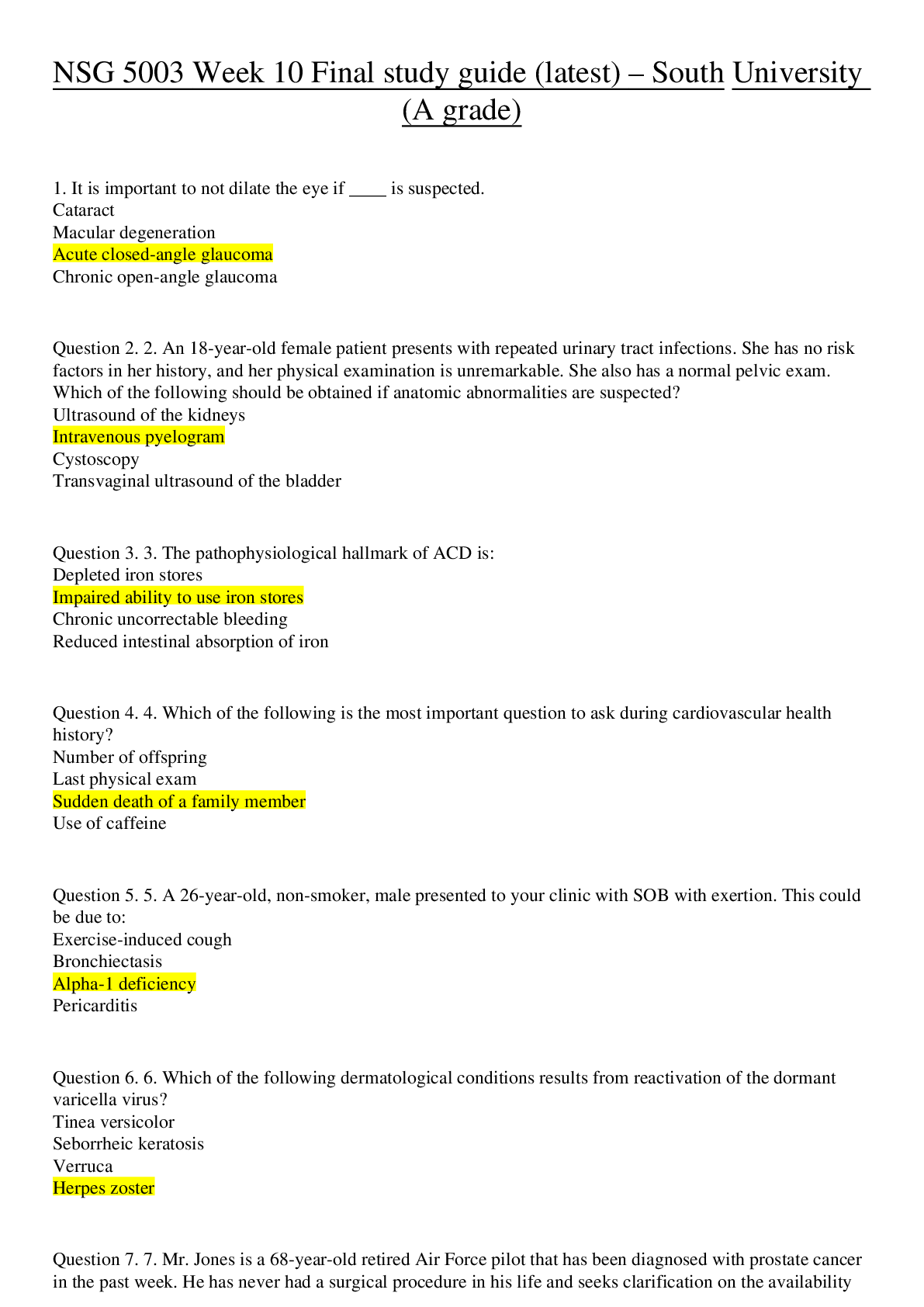
Reviews( 0 )
Document information
Connected school, study & course
About the document
Uploaded On
May 18, 2020
Number of pages
67
Written in
Additional information
This document has been written for:
Uploaded
May 18, 2020
Downloads
0
Views
70

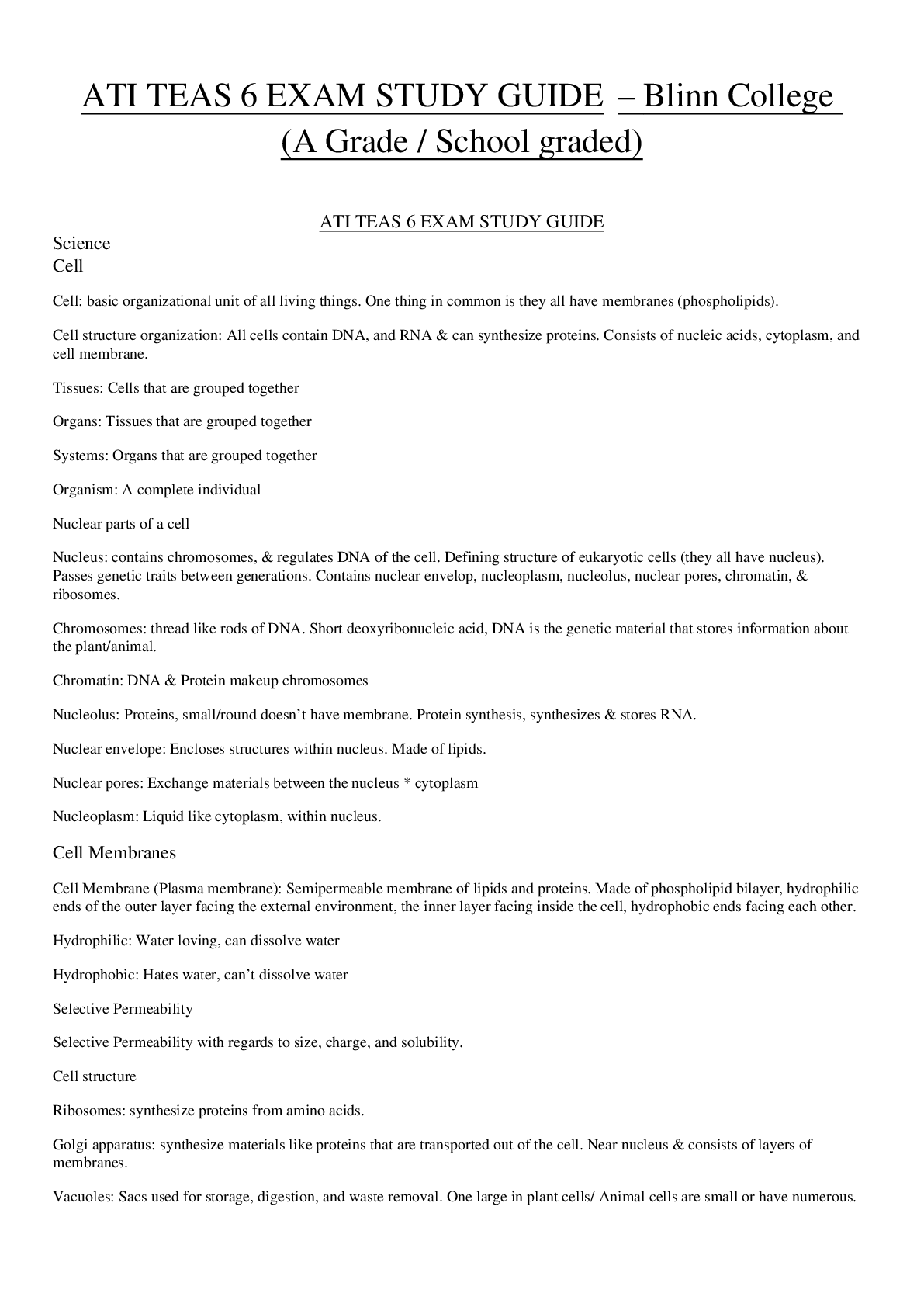
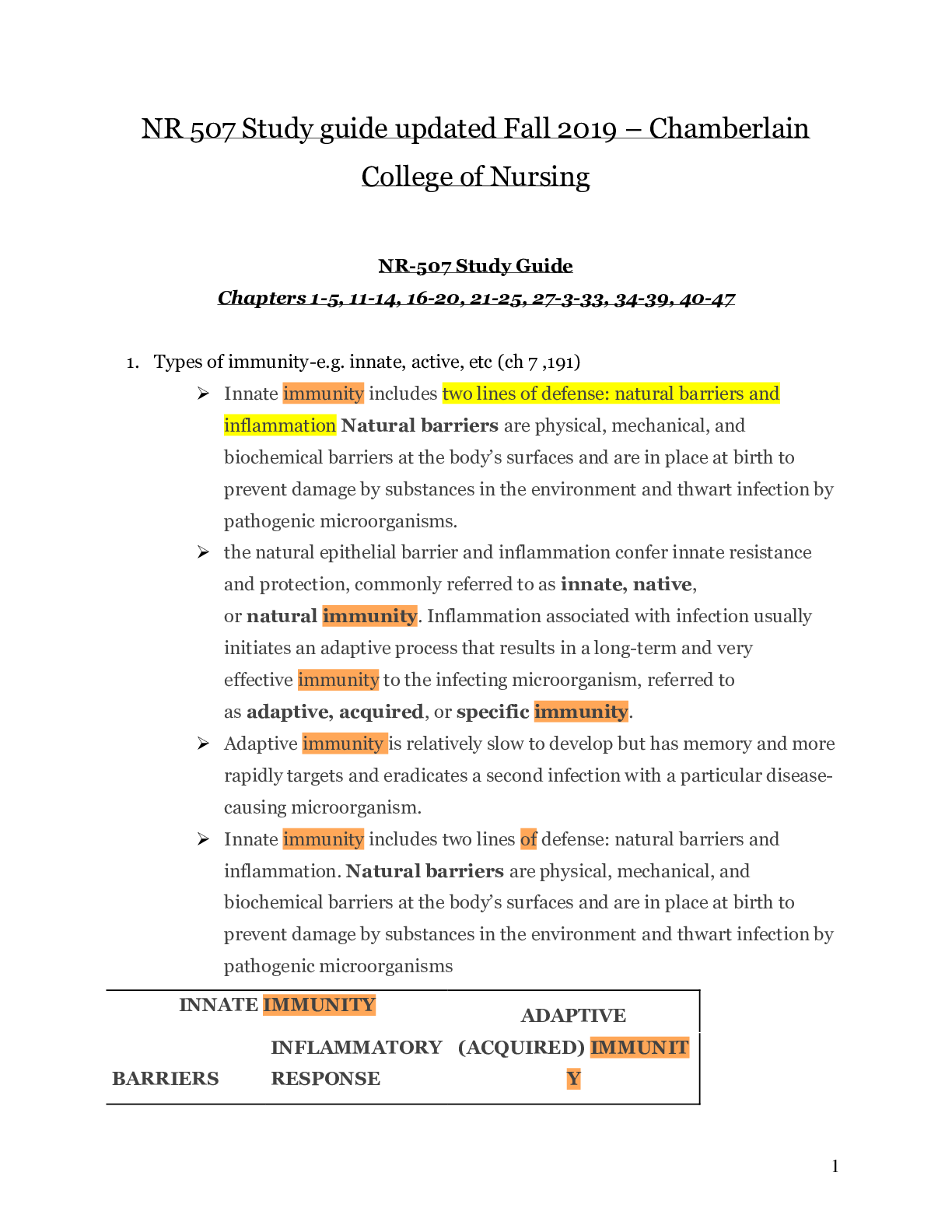

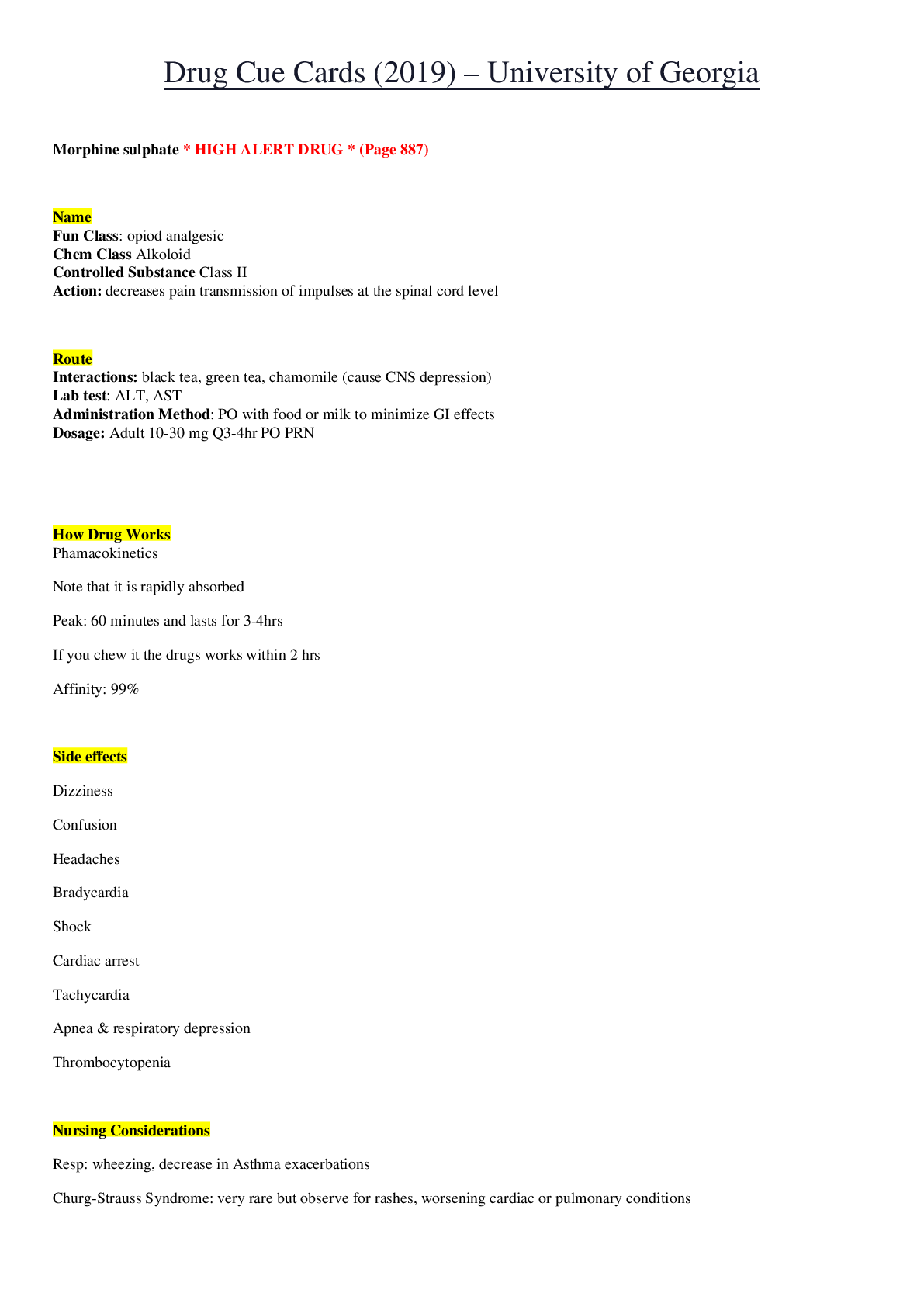
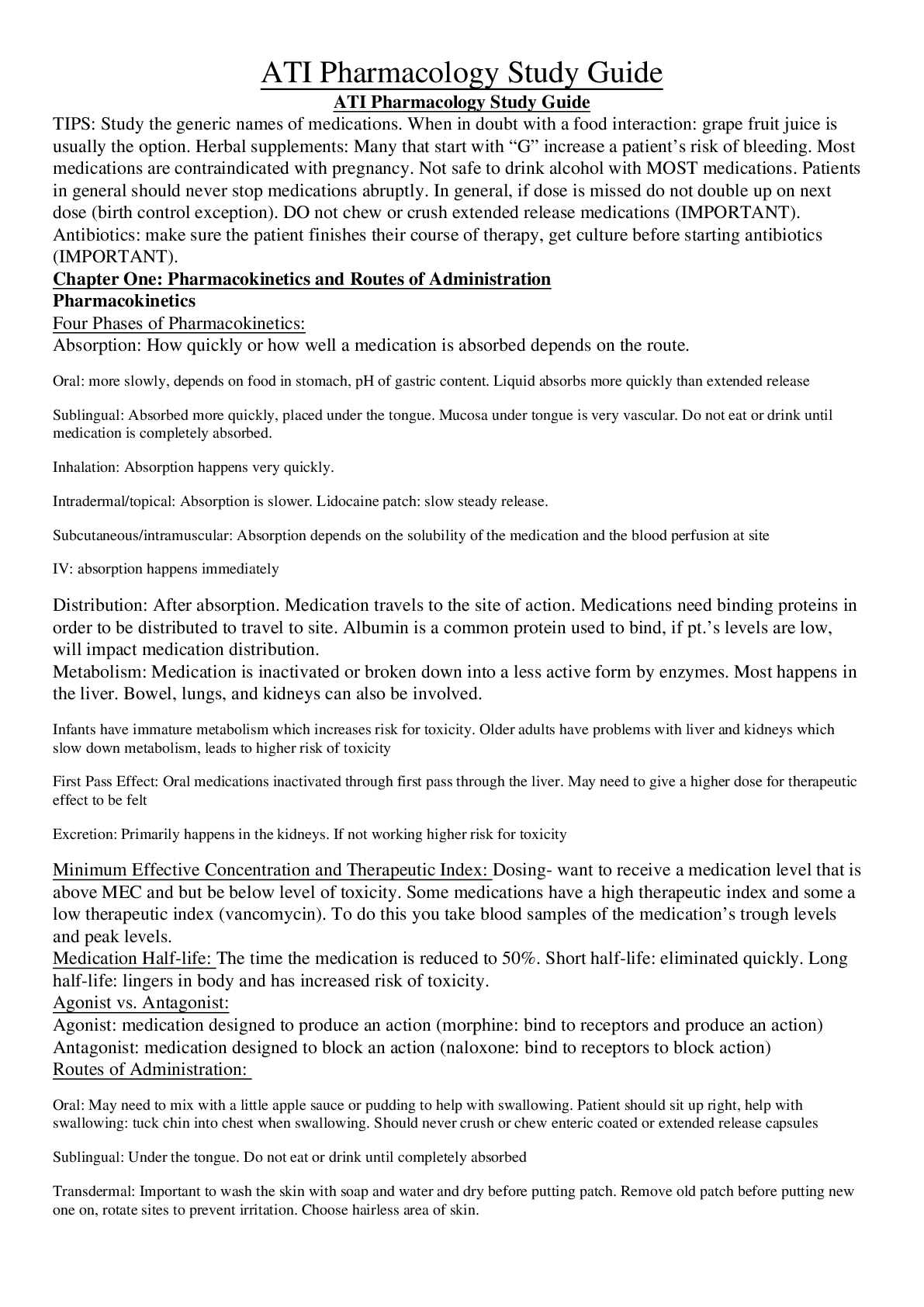
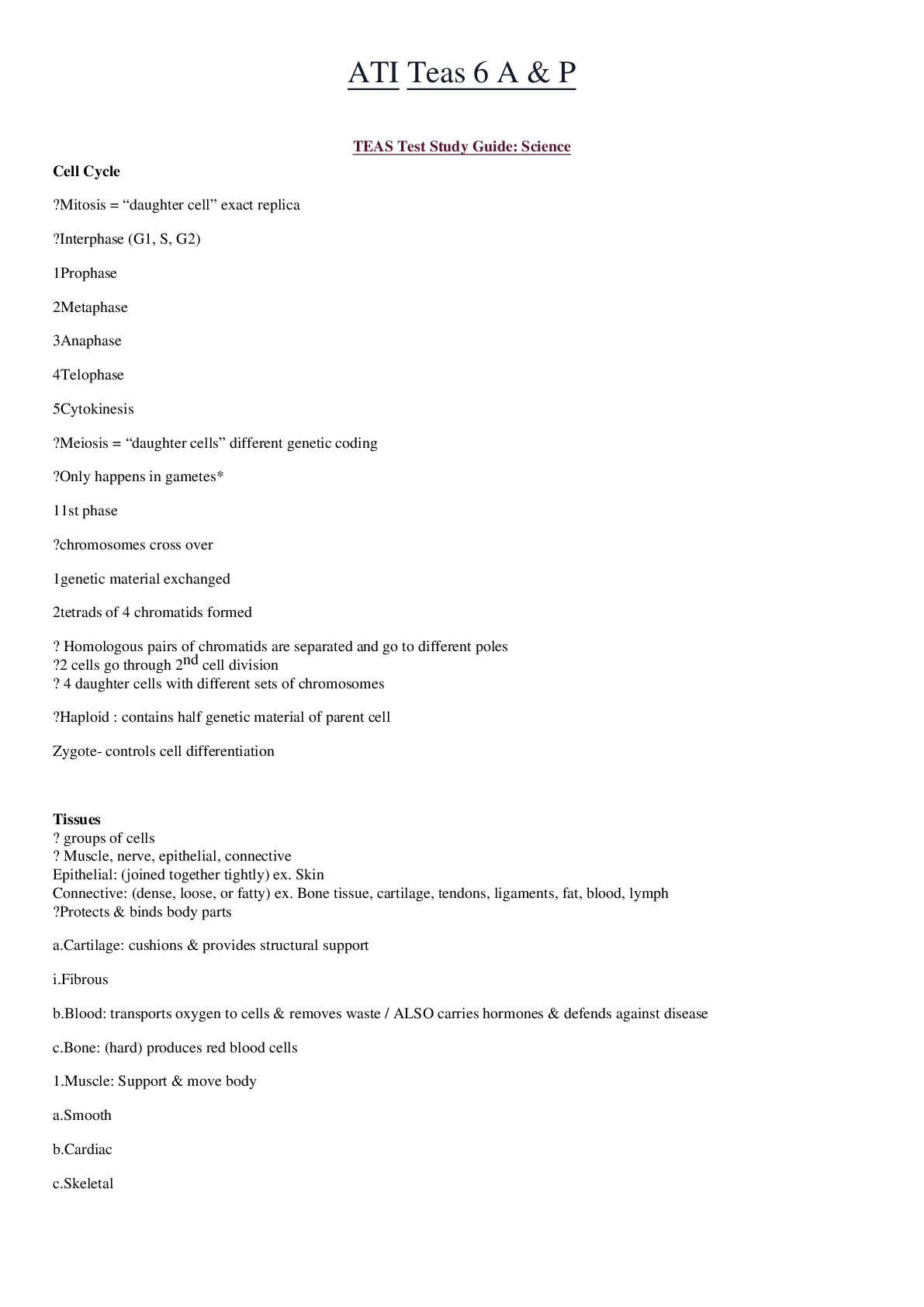
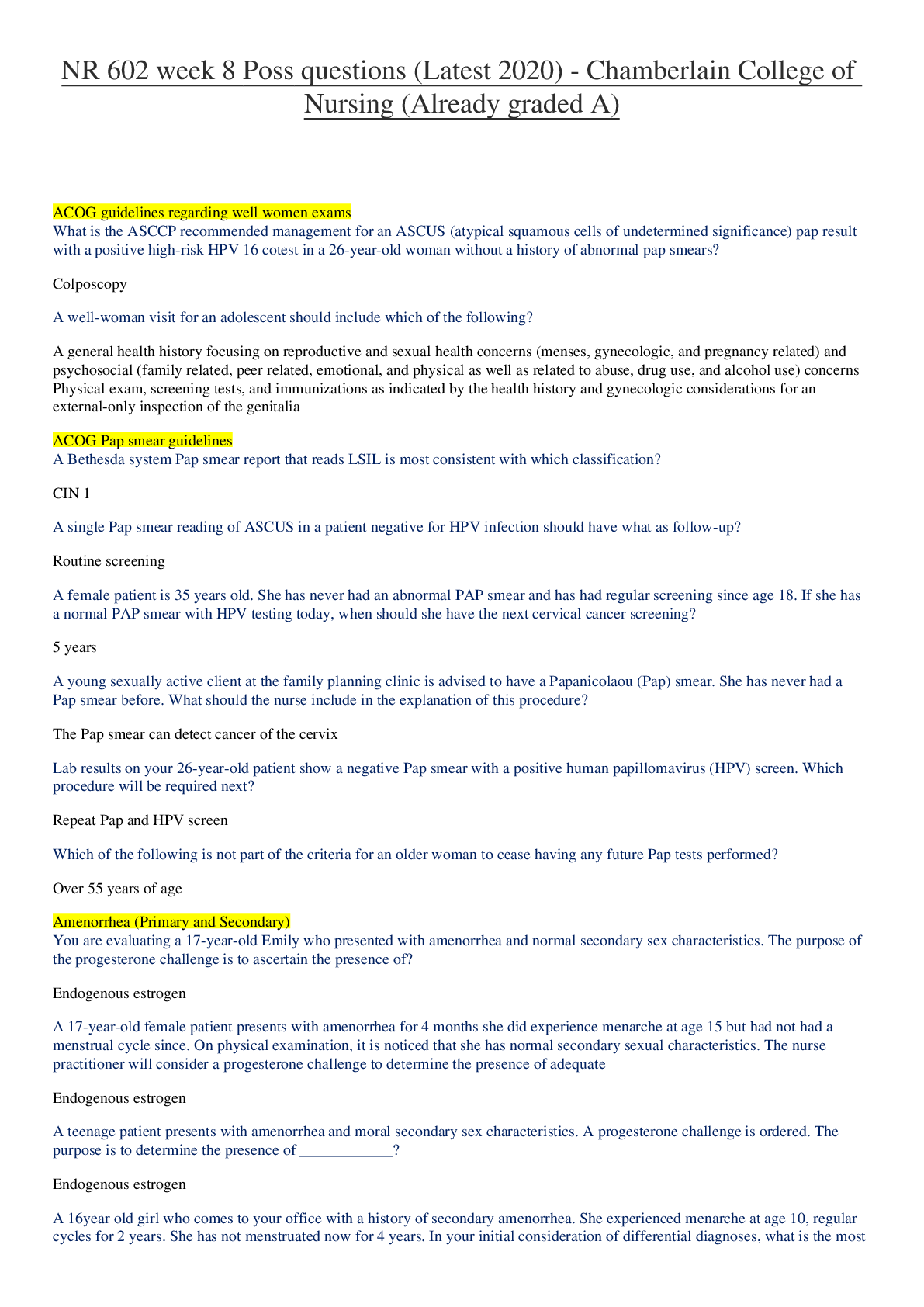
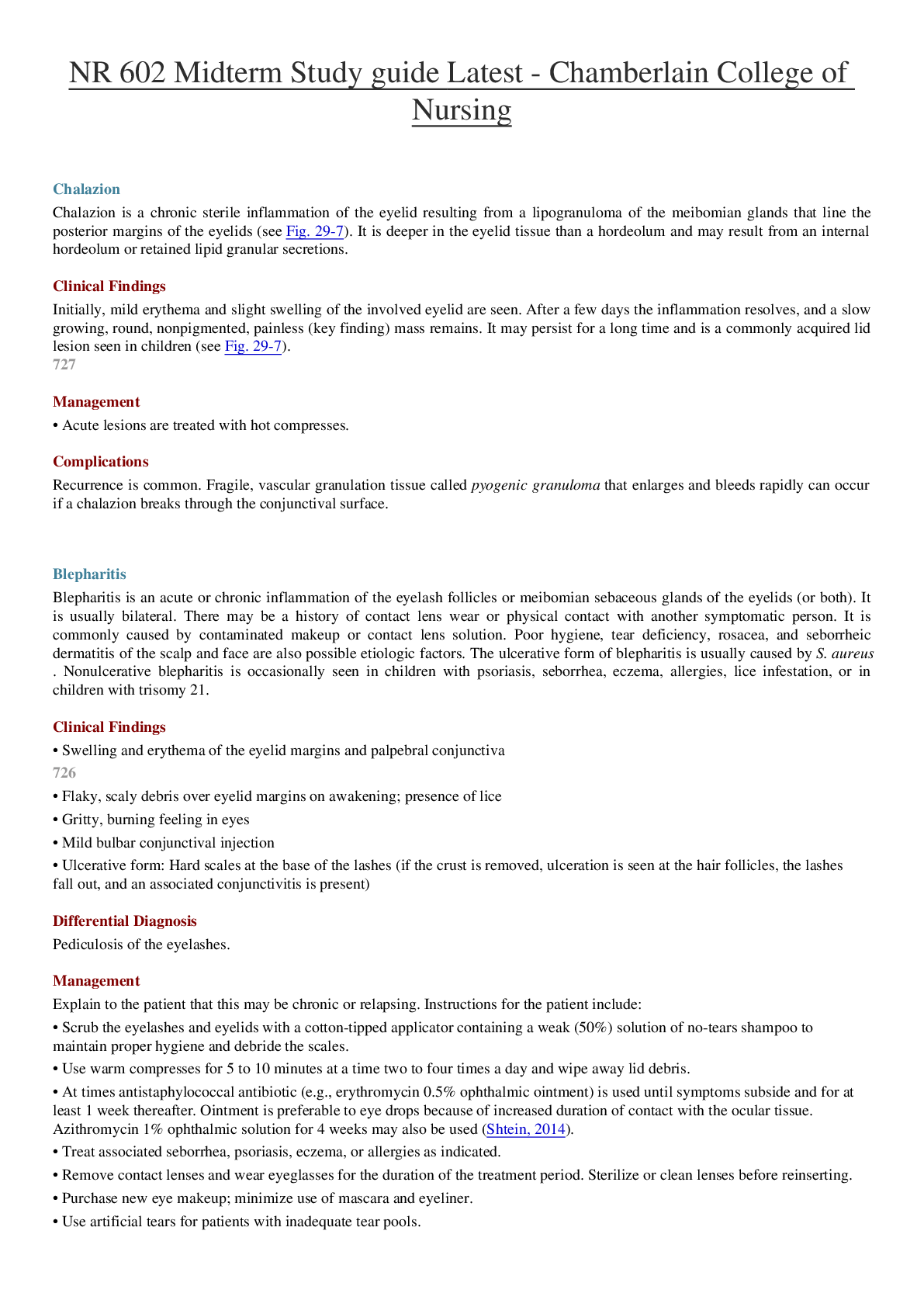
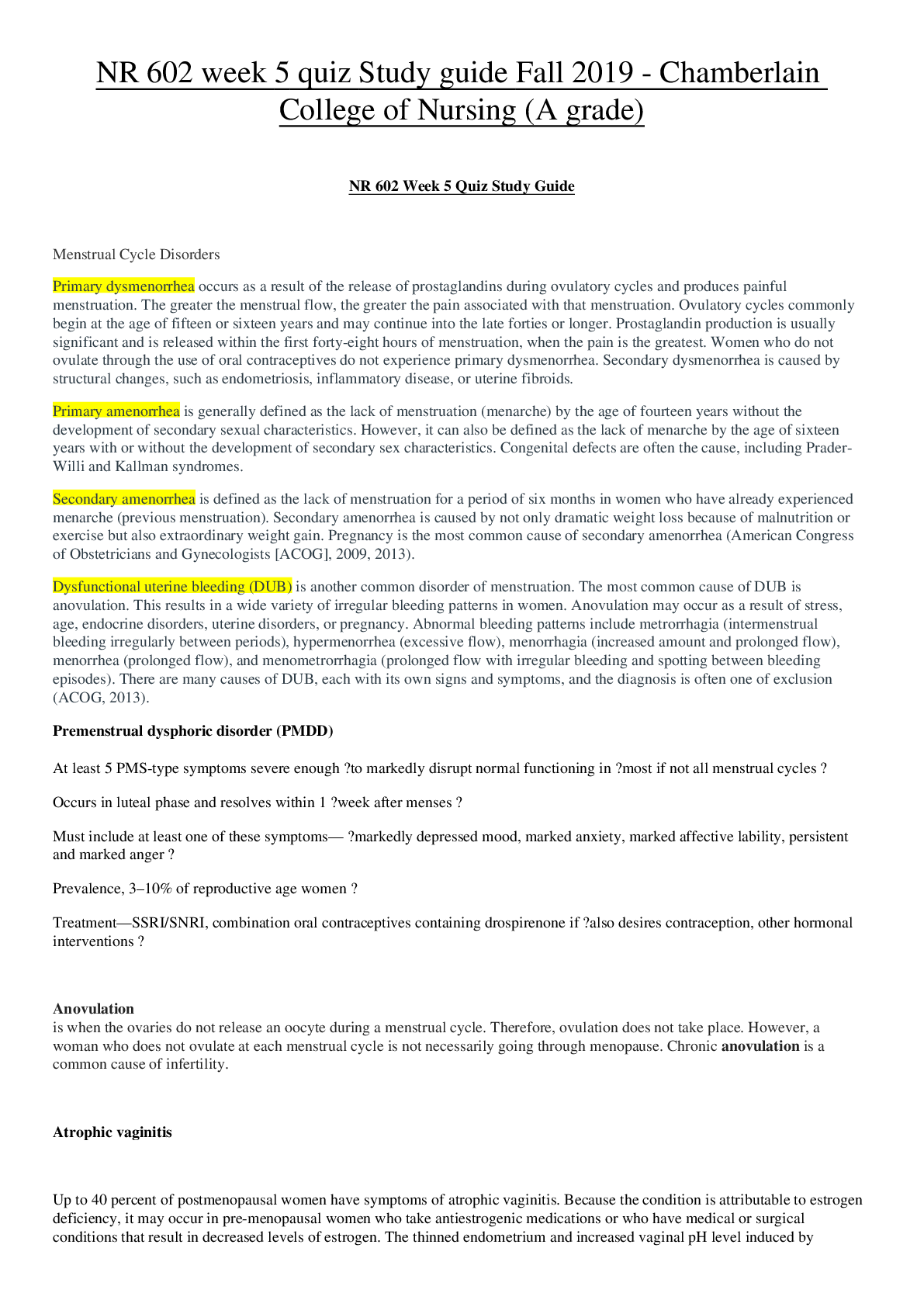
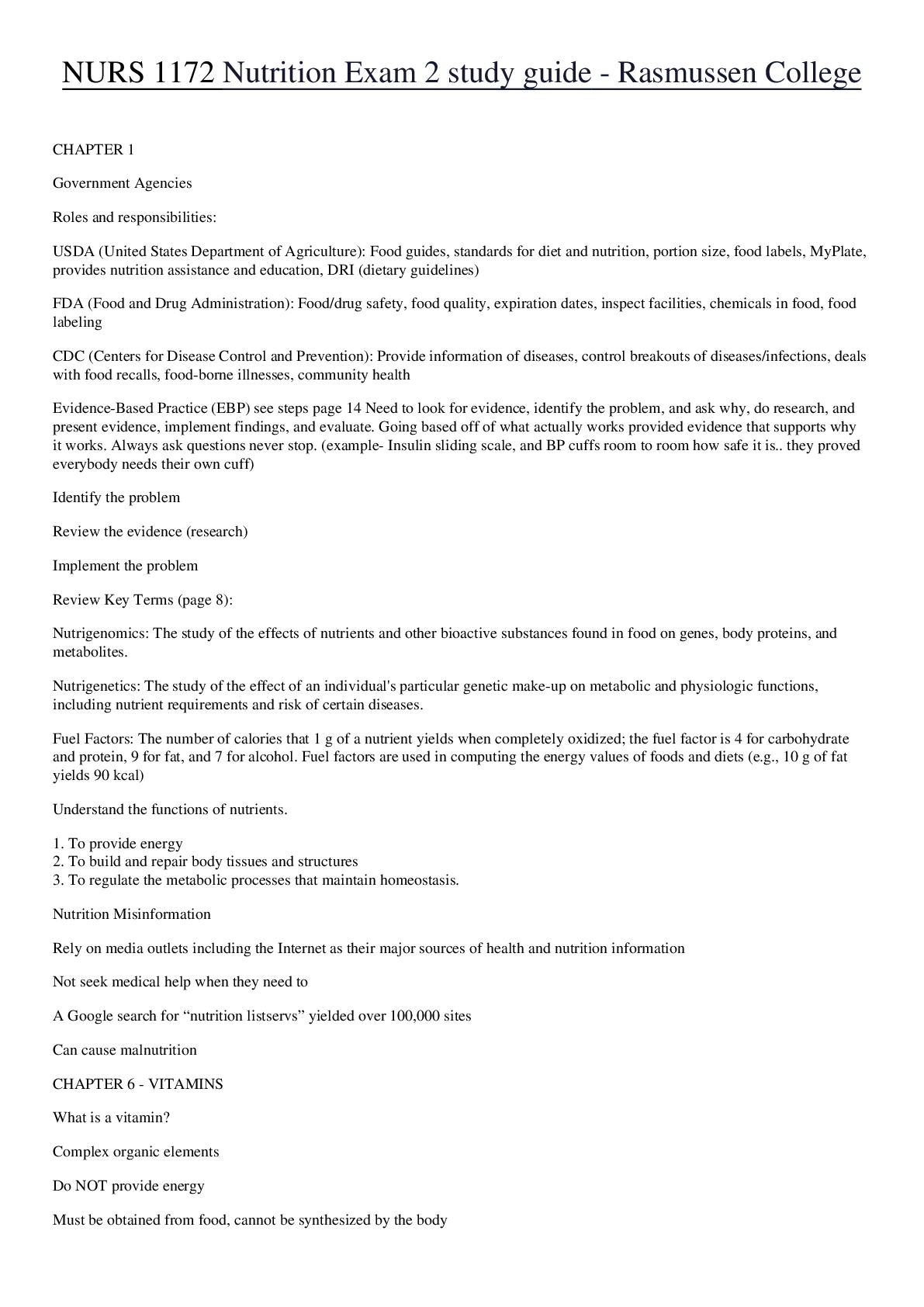
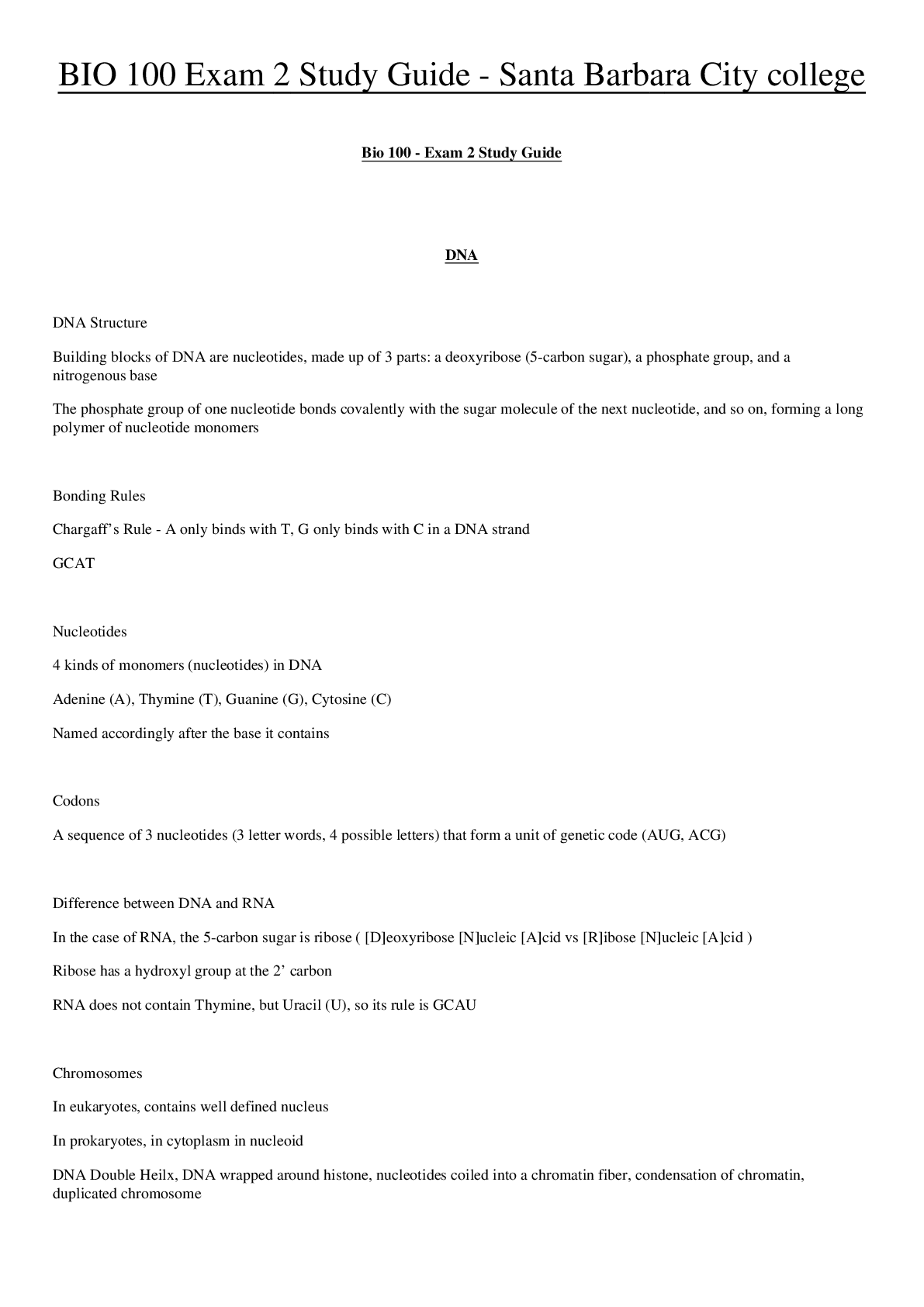
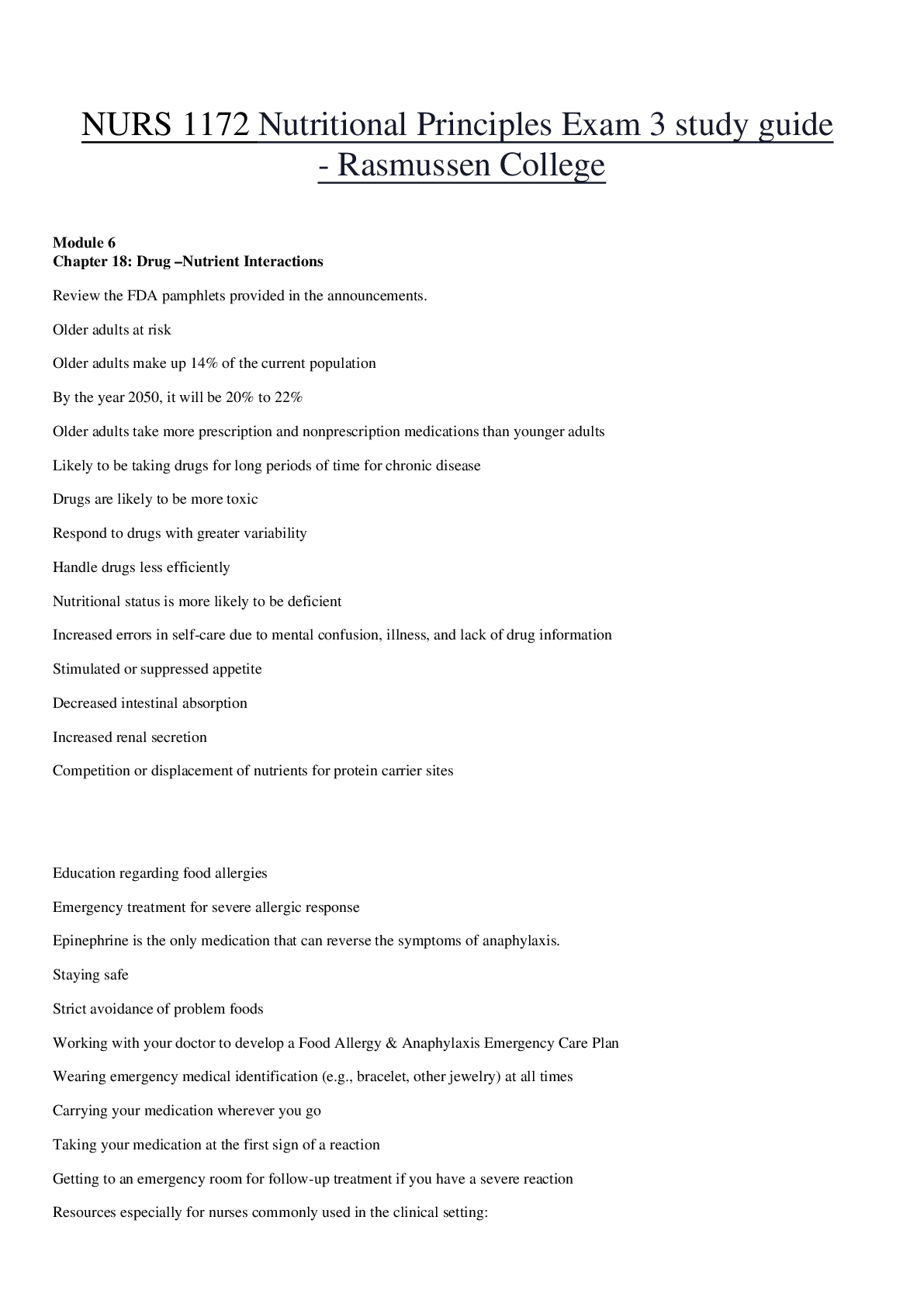
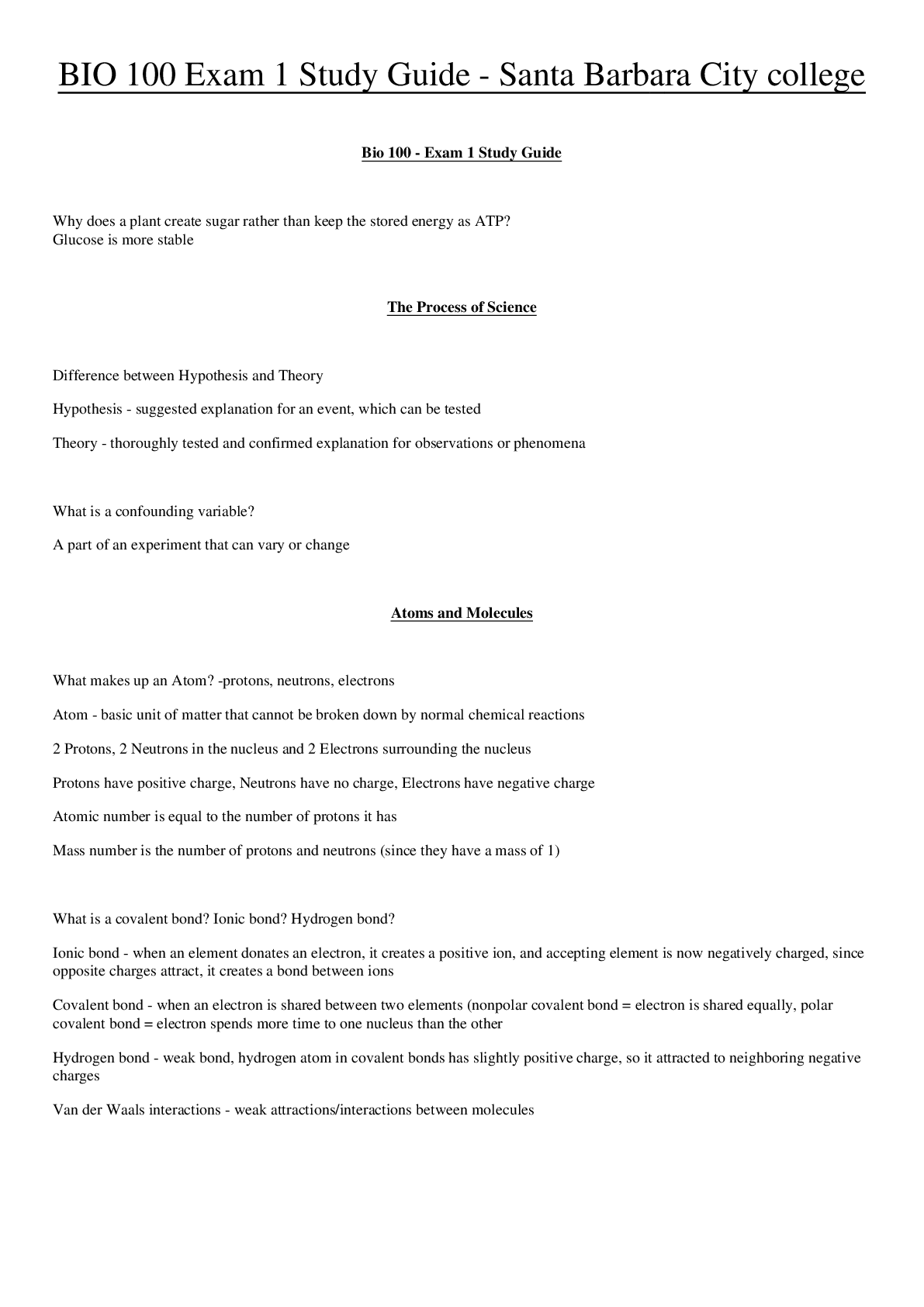
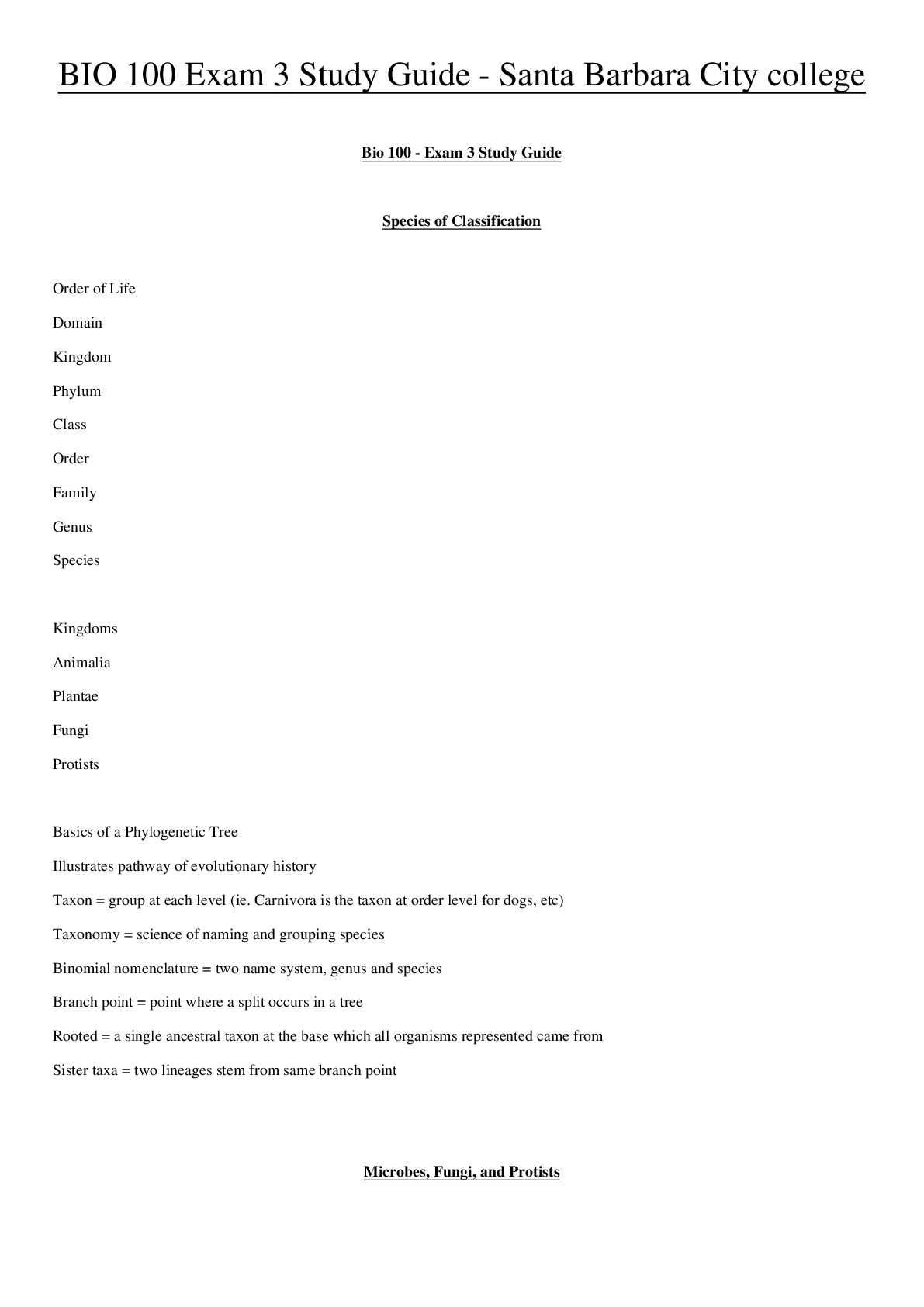
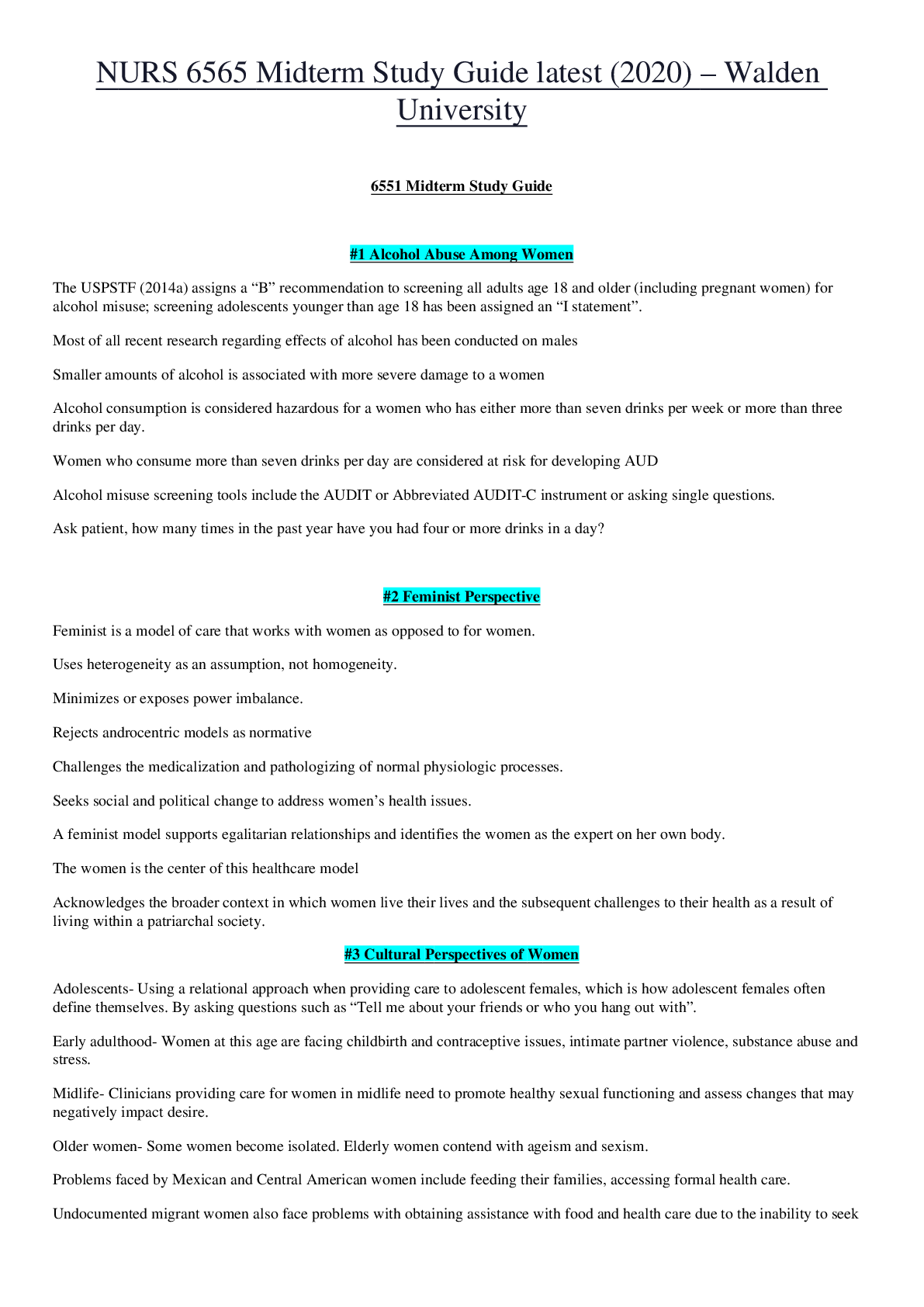


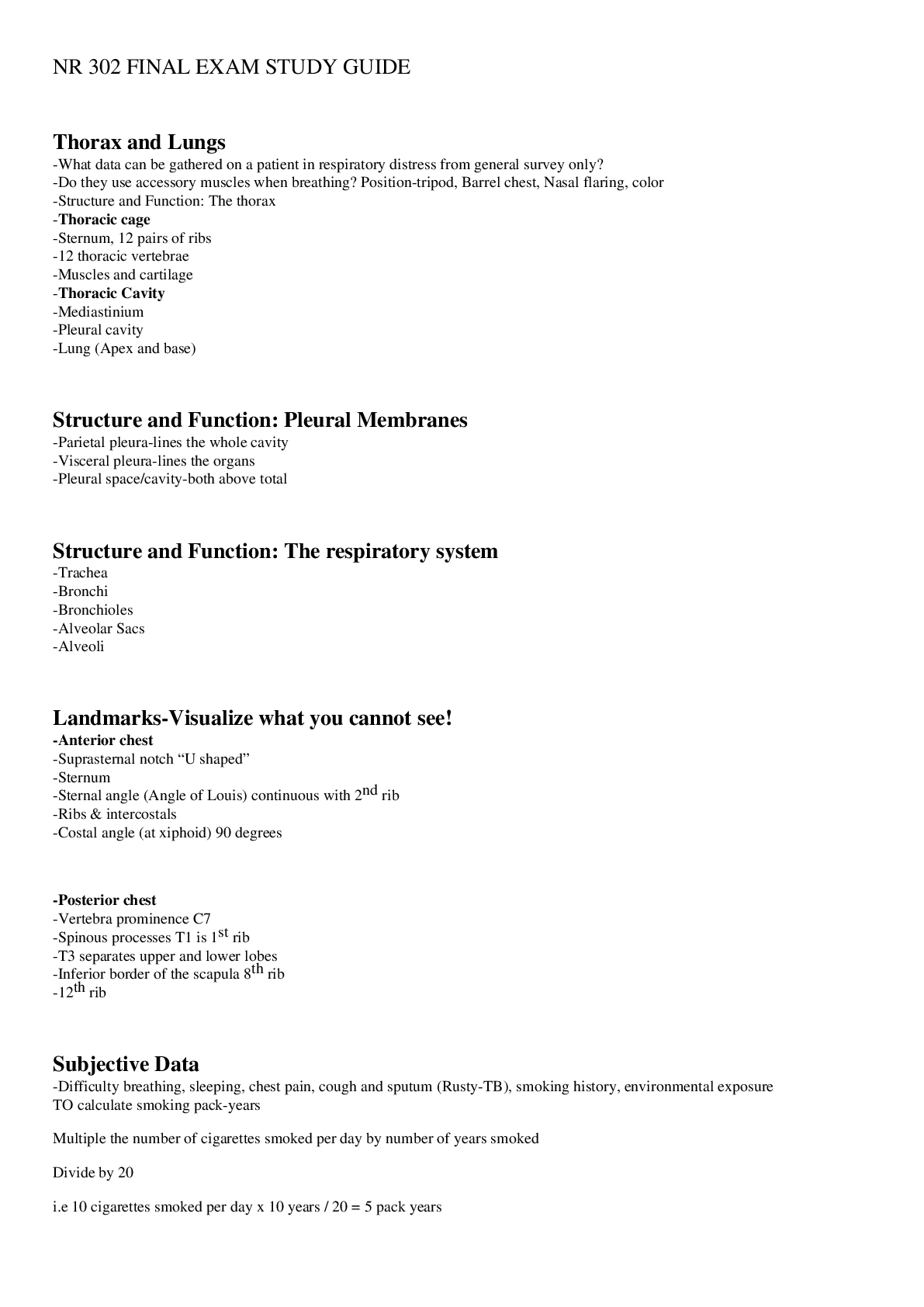
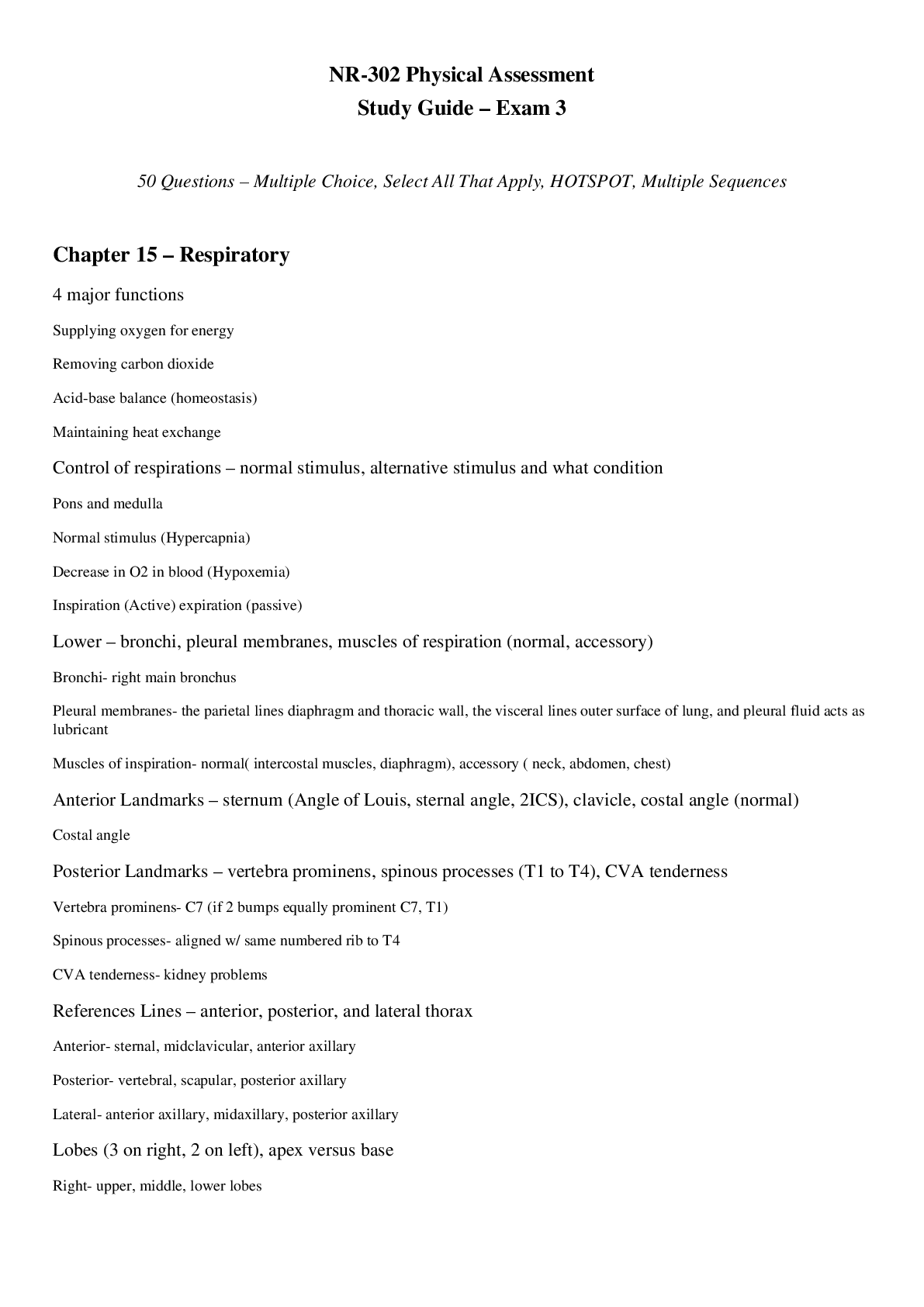
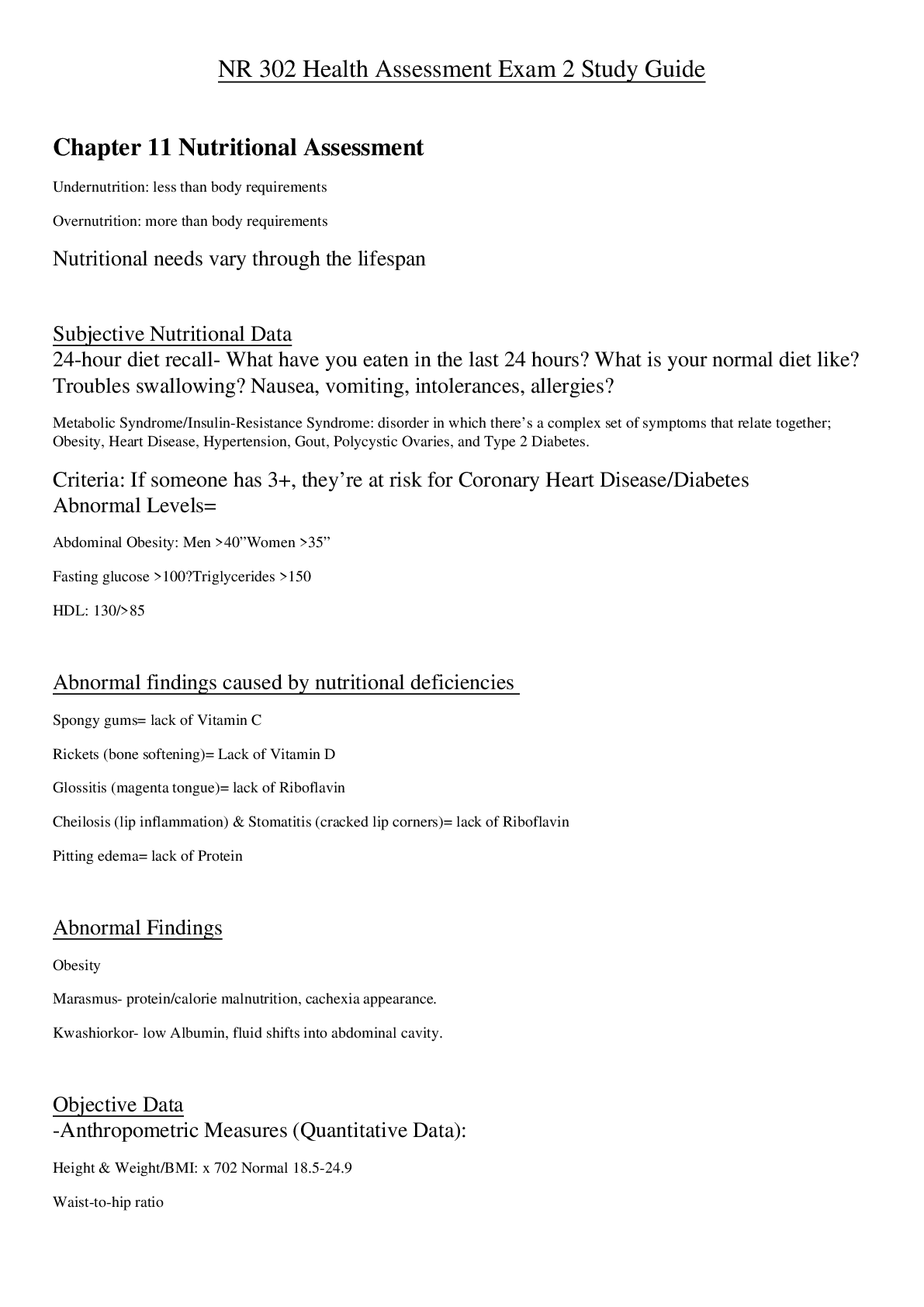



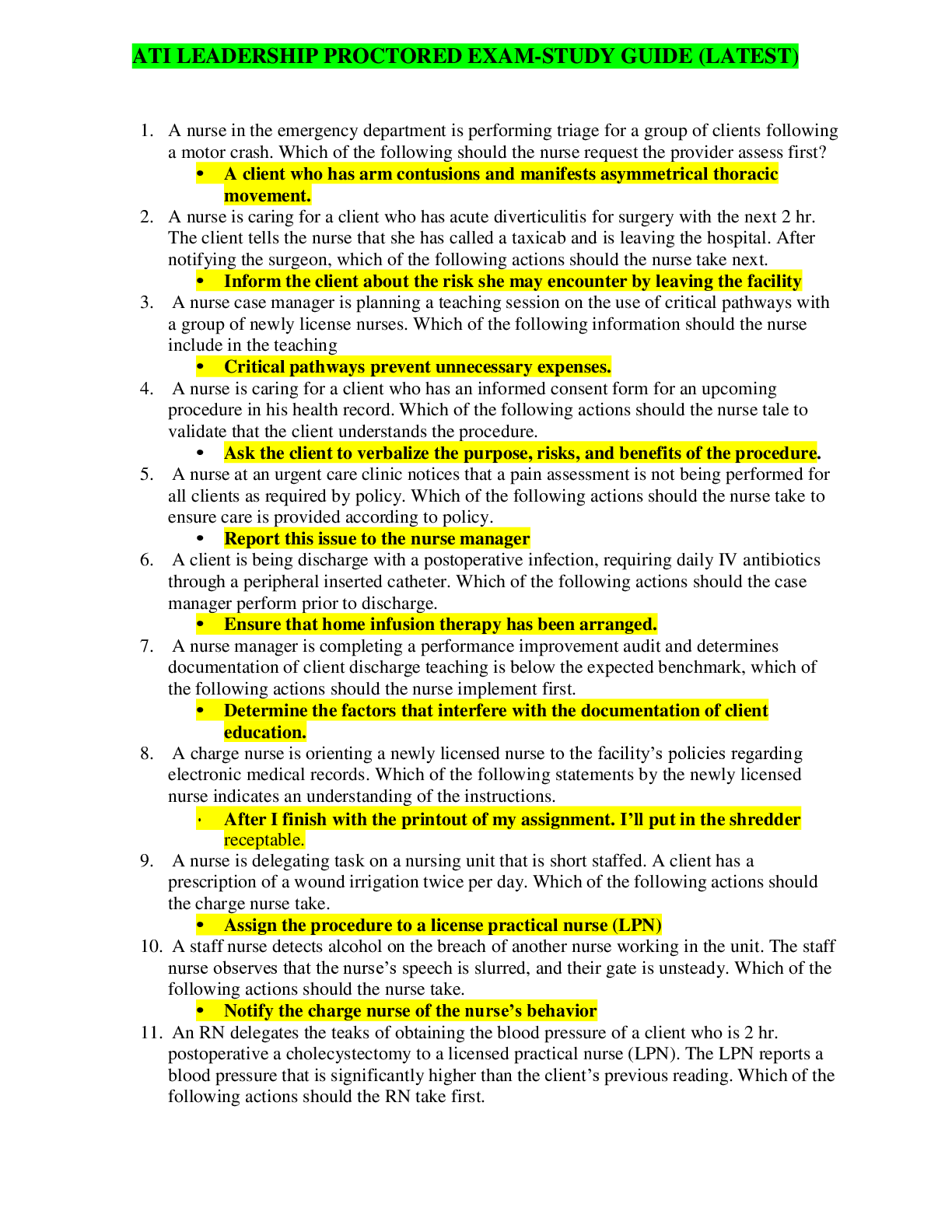

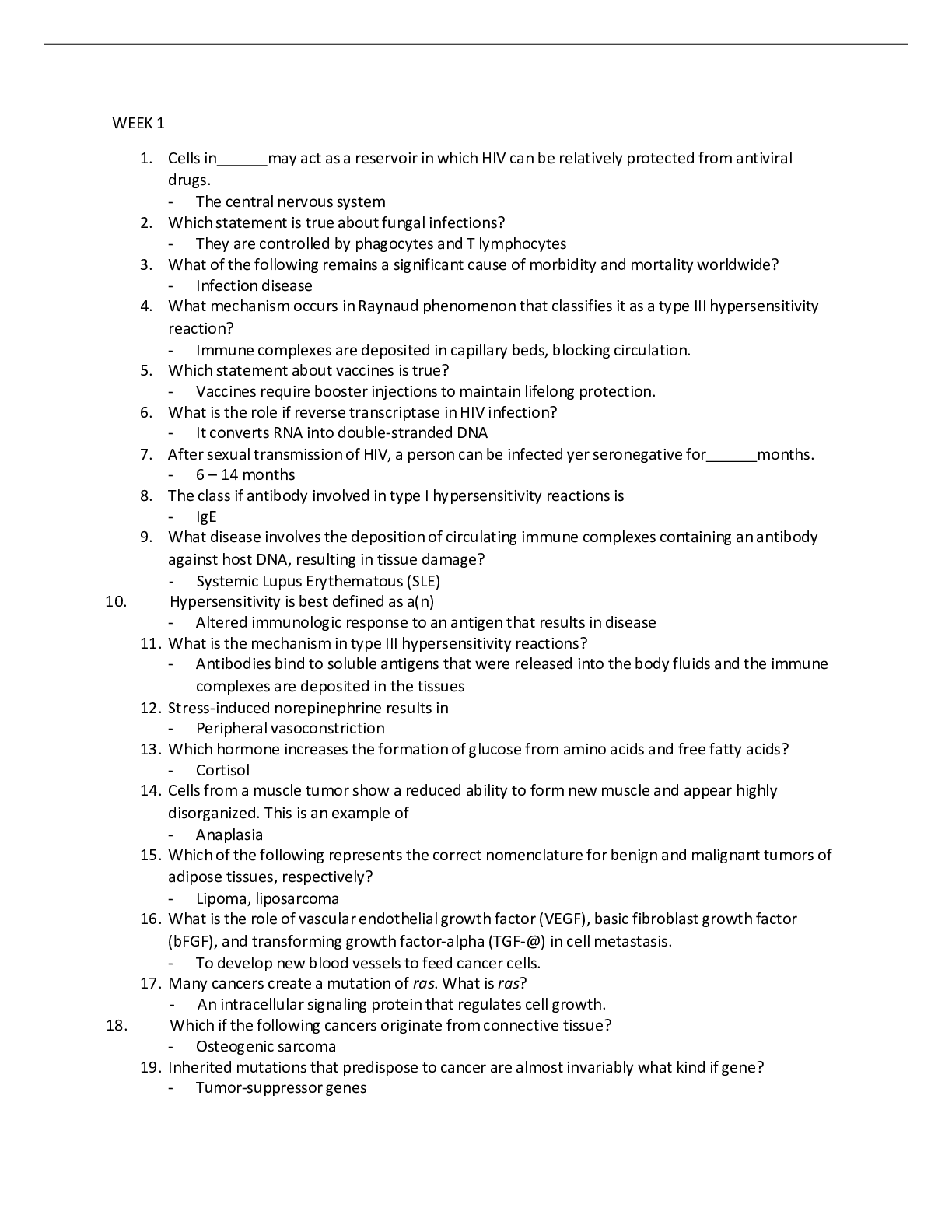
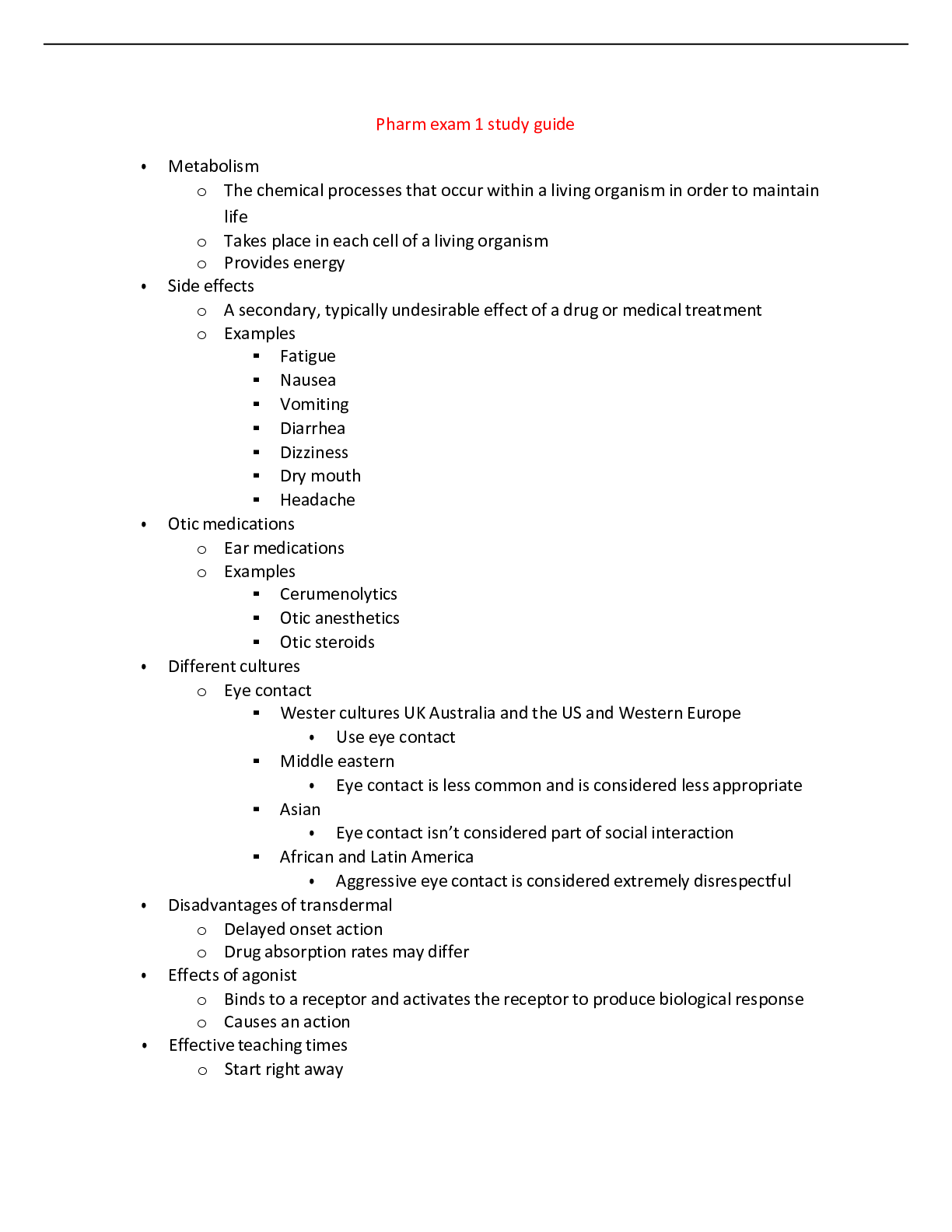
.png)
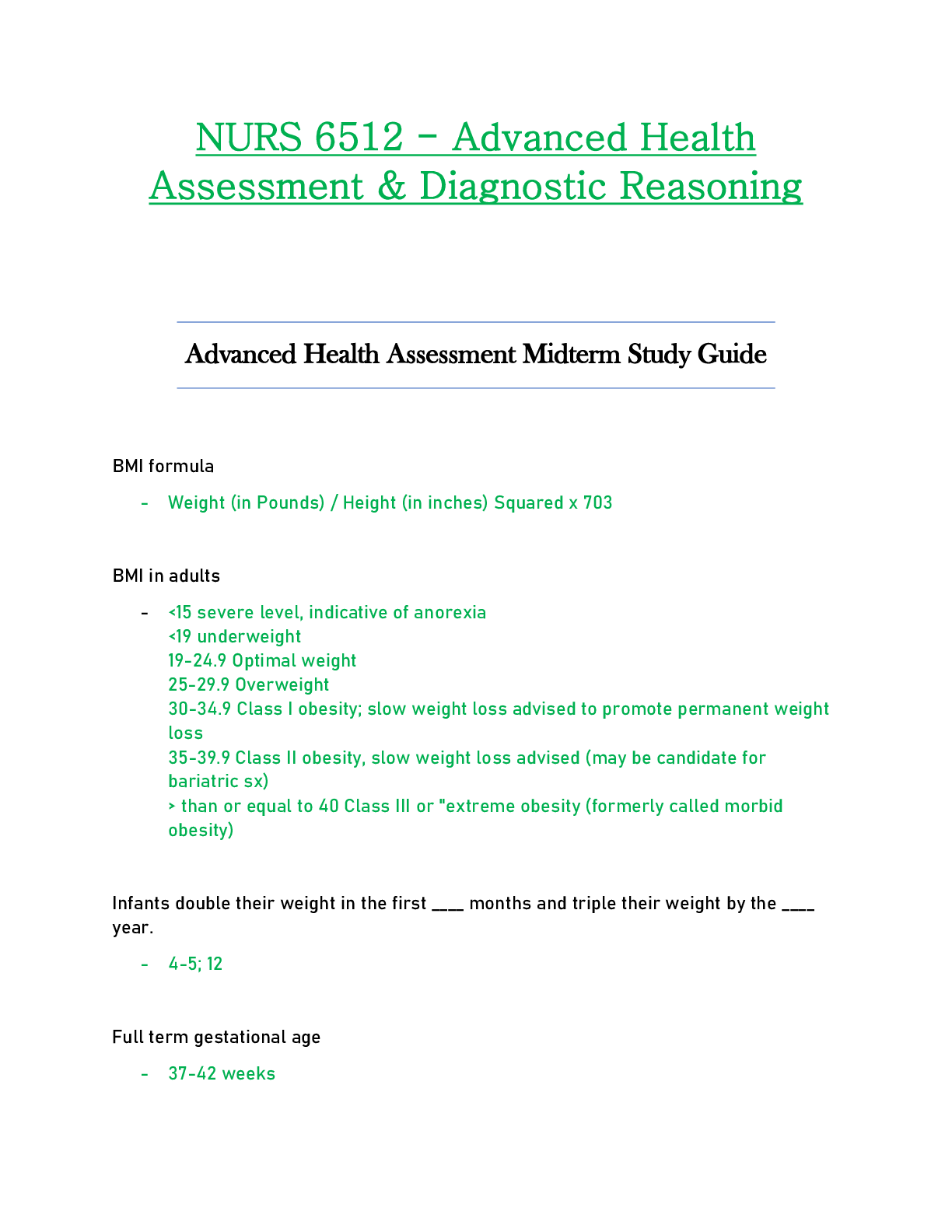

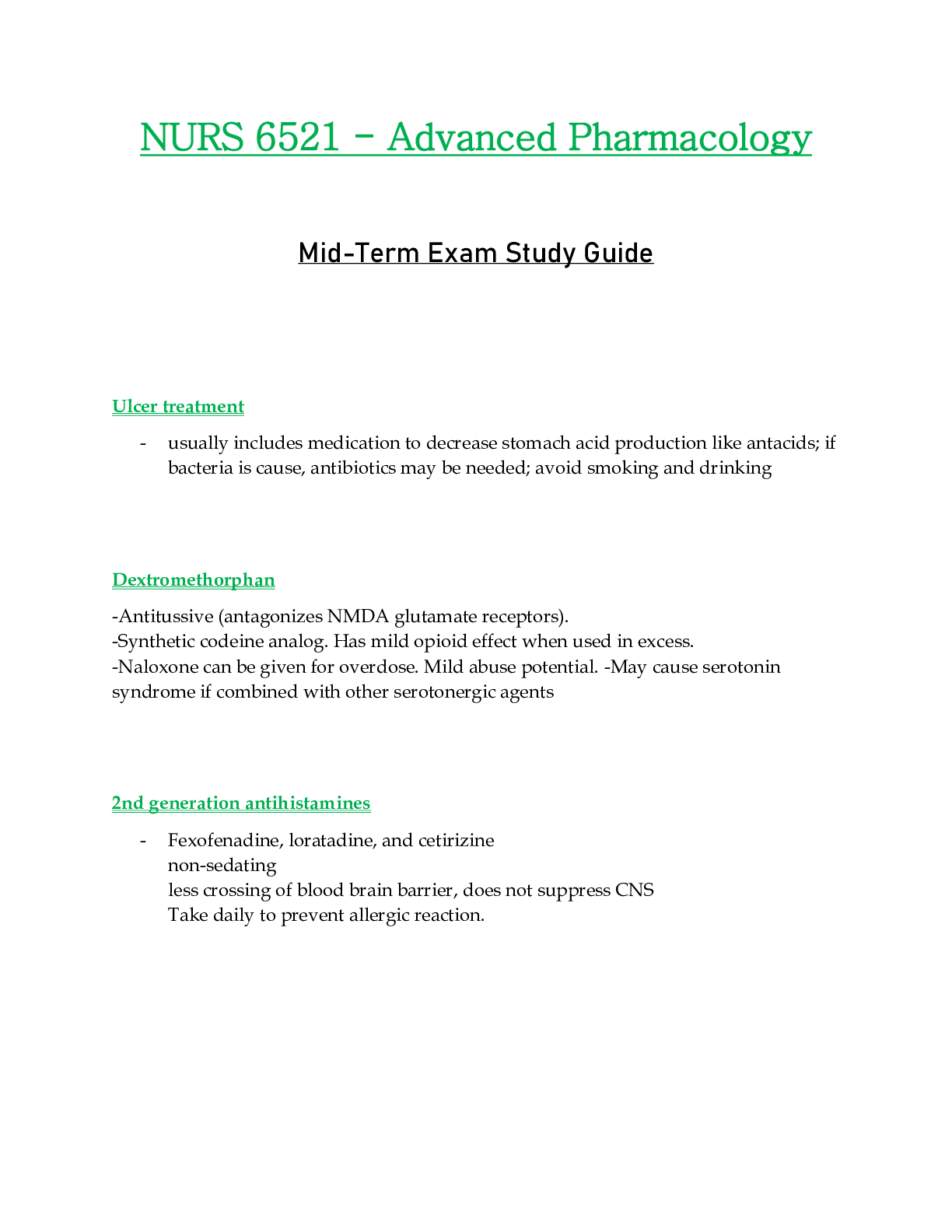

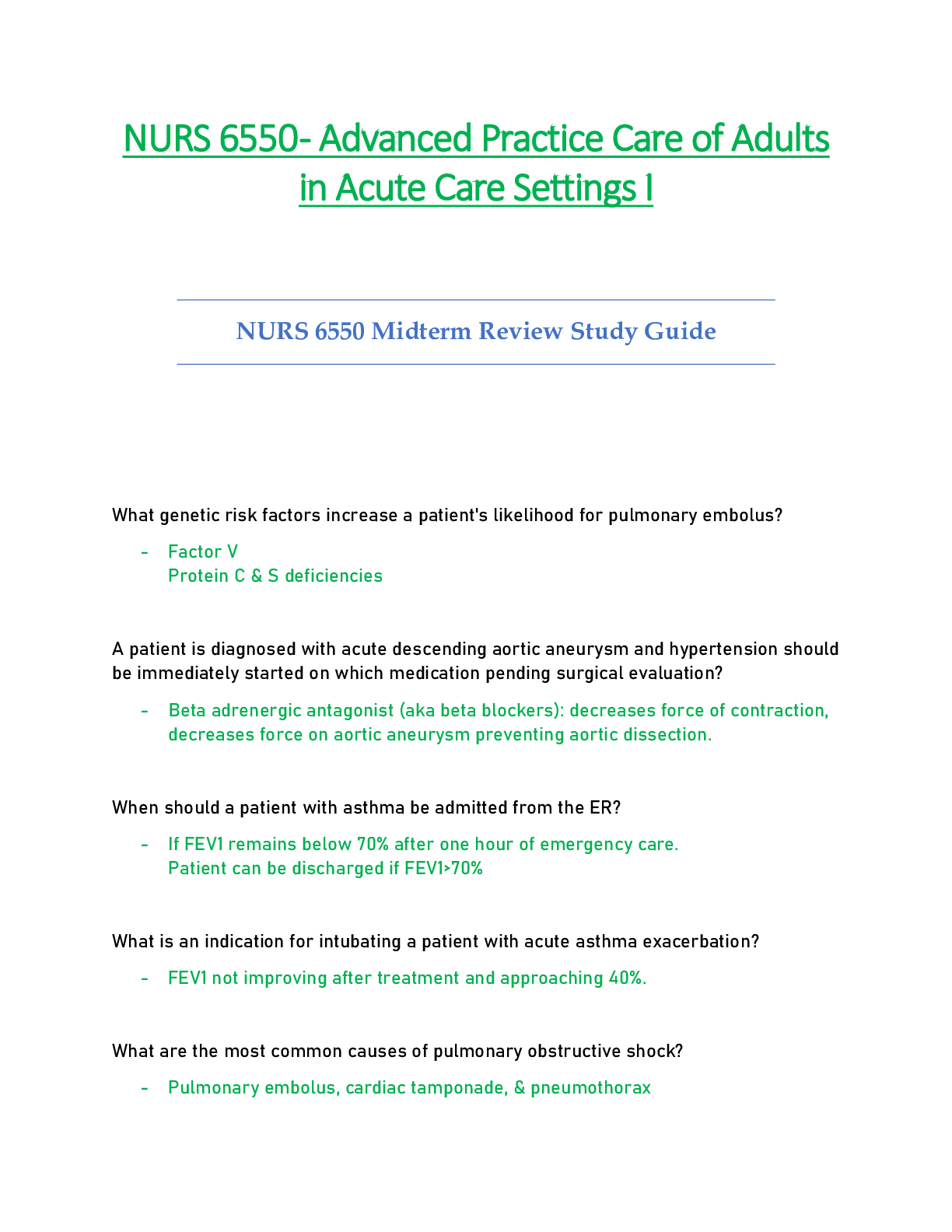
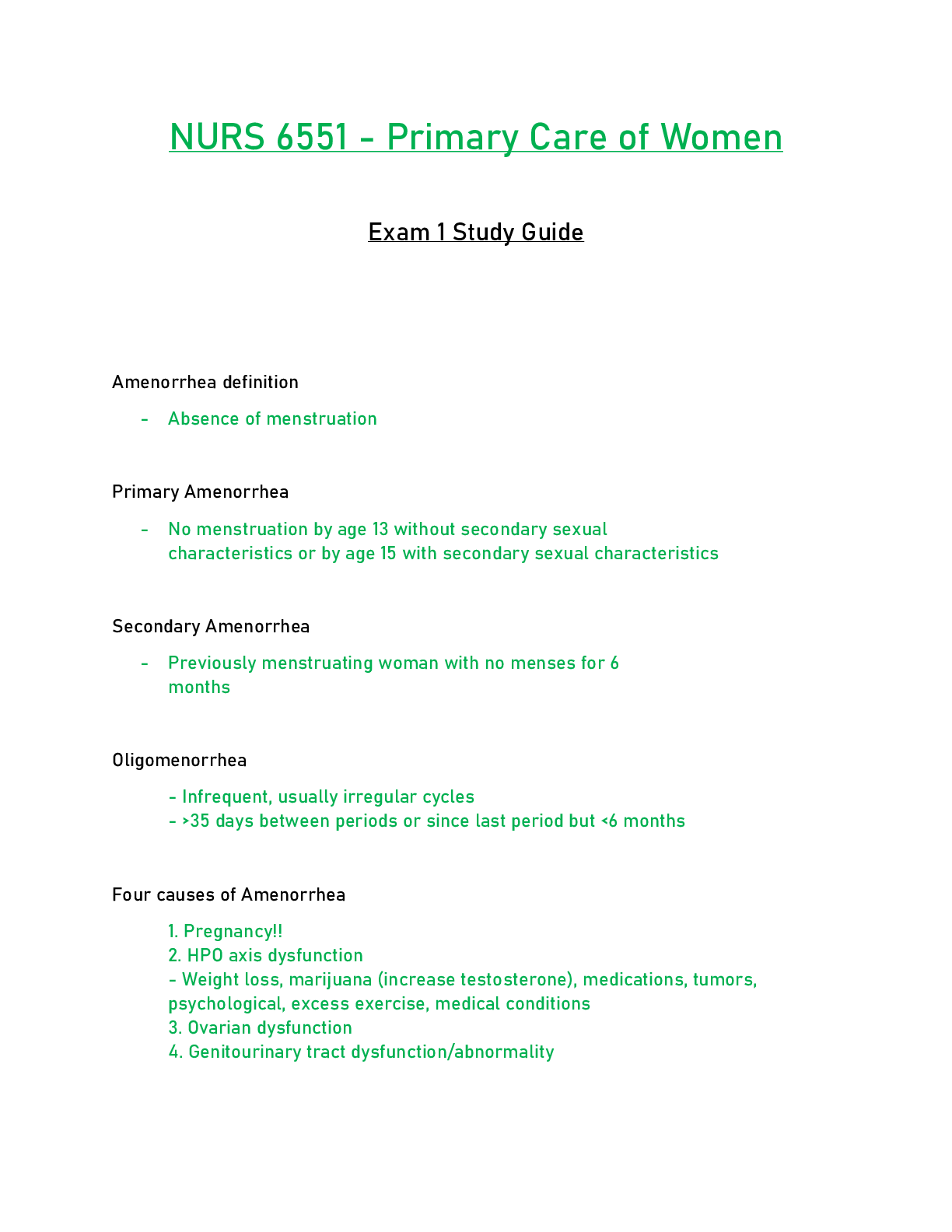
 SOUTH UNIVERSITY (GRADED A).png)
